Abstract
The southern margin of the Siberian craton hosts numerous Cu(Mo) and Mo(Cu) porphyry deposits. This review provides the first comprehensive set of geological characteristics, geochronological data, petrochemistry, and Sr–Nd isotopic data of representative porphyry Cu(Mo) and Mo(Cu) deposits within the southern margin of the Siberian craton and discusses the igneous processes that controlled the evolution of these magmatic systems related to mineralization. Geochronological data show that these porphyry deposits have an eastward-younging trend evolving from the Early Paleozoic to Middle Mesozoic. The western part of the area (Altay-Sayan segment) hosts porphyry Cu and Mo–Cu deposits that generally formed in the Early Paleozoic time, whereas porphyry Cu–Mo deposits in the central part (Northern Mongolia) formed in the Late Paleozoic–Early Mesozoic. The geodynamic setting of the region during these mineralizing events is consistent with Early Paleozoic subduction of Paleo-Asian Ocean plate with the continuous accretion of oceanic components to the Siberian continent and Late Paleozoic–Early Mesozoic subduction of the west gulf of the Mongol–Okhotsk Ocean under the Siberian continent. The eastern part of the study area (Eastern Transbaikalia) hosts molybdenum-dominated Mo and Mo–Cu porphyry deposits that formed in the Jurassic. The regional geodynamic setting during this mineralizing process is related to the collision of the Siberian and North China–Mongolia continents during the closure of the central part of the Mongol–Okhotsk Ocean in the Jurassic. Available isotopic data show that the magmas related to porphyritic Cu–Mo and Mo–Cu mineralization during the Early Paleozoic and Late Paleozoic–Early Mesozoic were mainly derived from mantle materials. The generation of fertile melts, related to porphyritic Mo and Mo–Cu mineralization during the Jurassic involved variable amounts of metasomatized mantle source component, the ancient Precambrian crust, and the juvenile crust, contributed by mantle-derived magmatic underplating.
1. Introduction
Porphyry Cu–Mo deposits occur in areas, which were involved in multiple magmatic events and are temporally and spatially associated with porphyritic intrusions. The deposits of this type were formed as a result of mantle–crust interaction and are usually associated with magmas varying in composition from mafic to intermediate and felsic [1]. Understanding their source composition, relationship, and role in ore formation is of primary importance in the modeling of the evolution of porphyry Cu–Mo systems. However, there is no general consensus on the role of crust and mantle in the evolution of ore-magmatic Cu–Mo porphyry systems and their metal fertility. The involvement of continental crust is regarded to be significant in the generation of Mo-rich porphyry systems [2]. On the other hand, some researchers consider the subduction-metasomatized mantle lithosphere as a possible source of Mo [3]. Copper is generally considered to be derived from the mantle [1,4]. Nevertheless, some researchers suggest a hybridized lower continental crustal source of Cu [5].
Porphyry Cu–Mo deposits have been shown to be mainly related to calc-alkaline magmas, generated in volcanoplutonic arcs in the active subduction zone [1,4,6,7,8]. The classical examples are located within Western Pacific and Central Andes [7,9,10,11,12]. However, recent studies show that a number of porphyry Cu–Mo deposits have been formed in collisional zones or intracontinental tectonic settings in association with shoshonitic and high-K calc-alkaline magmas [13,14,15,16]. Examples include Yulong and Gangdese porphyry Cu deposits in Tibet, China [13,14,17], Dexing porphyry Cu deposit in South China [18], Sungun and Sar–Cheshmeh Cu–Mo porphyry deposits in Iran [7,19,20], and Saindak and Reko Diq Cu–Au deposits, Pakistan [21,22].
The Central Asian Orogenic Belt (CAOB) is one of the world’s most important porphyry copper–molybdenum belts. Numerous large porphyry Cu–Au/Mo deposits have been found in the CAOB, such as the Bozshakol, Nurkazgan, Kounrad, and Aktogai porphyry Cu–Au deposits in Kazakhstan [23,24,25,26,27,28,29], the Kal’makyr-Dalnee Cu–Au porphyry in Uzbekistan [27,30], the Oyu Tolgoi Cu–Au porphyry in Mongolia [31], the Duobaoshan Cu–Au, and the Wunugetushan Cu–Mo porphyry [27,32,33] in China. The representative porphyry Mo deposits are Baishan and Donggebi in East Tianshan, China [34,35,36], a group of deposits along the Xilamulunhe area in Southeast Inner Mongolia, China [37,38], and the Luming and Daheishan deposits in Northeast China [39,40].
A number of medium to large Paleozoic–Mesozoic porphyry Cu–Mo and Mo–Cu deposits are located in the eastern segment of CAOB within the southern margin of the Siberian craton on the territory of Russia and Mongolia, such as the Aksug porphyry Cu, Kyzyk-Chadr Cu–Mo, Sora Mo–Cu, Bugdaya Mo–W, Zhireken Mo–Cu, Shakhtama Mo, and Erdenetiin Ovoo Cu–Mo [41,42,43,44,45,46,47,48,49]. The geological characteristics of most of these deposits have been reported in Russian literature. Although numerous studies of magmatism have been made, details of the involvement of mantle and/or crust components in their formation had been poorly understood until recent years, particularly with respect to Sr–Nd isotopic characteristics and geochronology by zircon U–Pb dating. In this paper, in combination with our previous recent studies [48,50,51,52,53,54] and other published data, we describe and review the geological, geochemical, geochronological, and isotopic (Sr–Nd) characteristics of representative deposits from Southern Siberia (Russia) and Northern Mongolia. These data provide information on the source of magmas, as well as the relationship between magma and porphyritic Cu–Mo mineralization. Despite some common features in the evolution of magmatic systems and the associated mineralization under consideration, there are some peculiar petrogeochemical characteristics of magmatic assemblages for individual deposits. These data allow for the definition of common and specific features in the evolution of ore-magmatic systems, providing new constraints on the role of the mantle–crust interaction in porphyritic Cu–Mo mineralization in the southern margin of the Siberian craton.
2. Time–Space Distribution of Porphyry Cu(Mo) and Mo(Cu) Deposits within the Southern Margin of the Siberian Craton
Porphyry Cu(Mo) and Mo(Cu) deposits are spatially distributed along the southern margin of the Siberian craton (Figure 1). This region is the eastern segment of Central-Asian Orogenic Belt (CAOB), situated between the Siberian craton on the north and the North China and Tarim cratons in the south. The deposits vary in size, and Cu and Mo grades. The emplacement ages of porphyry intrusions related to Cu(Mo) and Mo(Cu) mineralization in this region range from Cambrian to Middle-Upper Jurassic. According to the ages of ore-bearing porphyritic intrusions and their spatial distribution, three ore belts may be distinguished: the Early-Middle Paleozoic porphyry Cu(Mo) + Mo–Cu belt (Altai-Sayan segment, Russia), the Late Paleozoic–Early Mesozoic porphyry Cu–Mo belt (Northern Mongolia), and the Mesozoic porphyry Mo(Cu) belt (Eastern Transbaikalia, Russia). In general, the deposits delineate a younging trend with a decreasing Cu/Mo ratio from west to east.
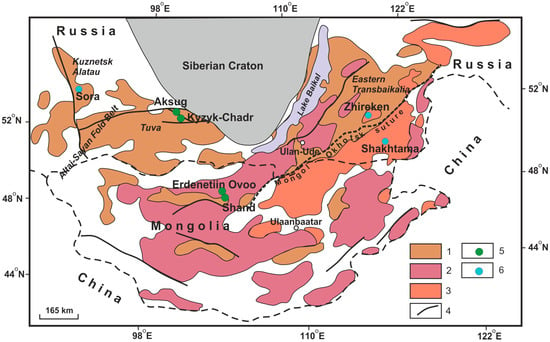
Figure 1.
Paleozoic-Mesozoic magmatism within the southern margin of the Siberian craton and the location of principal porphyry Cu(Mo) and Mo(Cu) deposits. 1–3: Magmatic belts. 1—Early Paleozoic; 2—Late Paleozoic to Early Mesozoic; 3—Mesozoic; 4—faults; 5—porphyry Cu(Mo) deposits; 6—porphyry Mo(Cu) deposits.
Altai-Sayan area. Significant porphyry Cu–Mo and Mo–Cu mineralization occurred within the Altai-Sayan segment of the Early–Middle Paleozoic porphyry Cu(Mo) + Mo–Cu belt. The Altay-Sayan segment contains operating Sora porphyry Mo–Cu deposits, explored Aksug porphyry Cu, and Kyzyk-Chadr porphyry Cu–Mo deposits (Figure 1). The Aksug and Kyzyk-Chadr deposits are located in the Tuva region within the Southeast Altai-Sayan area, while the Sora deposit is situated in the Kuznetsk Alatau Mountains within the Northwest Altai-Sayan area. Porphyry Cu and Mo–Cu mineralization in this area is related to the emplacement of Cambrian to Early Devonian porphyritic intrusions [42,55,56].
Northern Mongolia. Large Erdenetiin Ovoo and small Shand porphyry Cu–Mo deposits (Figure 1), along with numerous porphyry Cu–Mo prospects and occurrences, are located on the territory of Northern Mongolia. Thirteen of the 72 documented porphyry copper prospects in this region are considered to be significant [57]. Most porphyry Cu–Mo occurrences in this belt constitute potential for concealed deposits at depths of 200 to 300 m [58]. Porphyry Cu–Mo mineralization in this area is related to a suite of Late Permian to Early Triassic porphyritic intrusions that range in composition from diorite through granodiorite to granite [49,59].
Eastern Transbaikalia. Eastern Transbaikalia hosts numerous molybdenum-dominated Mo and Mo–Cu porphyry deposits and occurrences, among them are the operating Zhireken and the mined out Shakhtama deposits (Figure 1). Zhireken is located at the northward and the Shakhtama at the southward from the Mongol–Okhotsk suture zone. Porphyry Mo(Cu) mineralization in this region is related to the emplacement of felsic porphyritic intrusions of the Upper Jurassic age [52,60].
3. Regional Geology
Available geological data indicate that CAOB was developed from the Neoproterozoic through to the Early Mesozoic via the continuous accretion of oceanic components of the Paleo-Asian Oceanic basin (oceanic islands, island arcs, and back-arc basins) to the Siberian continent [61,62,63,64,65,66]. As a result, accretionary terranes were generated along the southern continental margin. Porphyry Cu–Mo and Mo–Cu deposits in the Altai-Sayan area, Northern Mongolia, and the northern part of Eastern Transbaikalia are hosted in terranes accreted to the Siberian continent in Cambrian [67].
The deposits are confined to transregional magmatic belts extending along the southern margin of the Siberian craton. These belts are associated with magmatic events related to the subductions of the Paleo–Asian Ocean in the Early Paleozoic [68], the west gulf of the Mongol–Okhotsk Ocean in the Late Paleozoic–Early Mesozoic [69], and the collision of the Siberian and North China–Mongolia continents during the closure of the central part of the Mongol–Okhotsk Ocean in the Jurassic [70]. From Paleozoic to Mesozoic, the western margin of the Paleo–Asian Ocean and the Mongol–Okhotsk basin were shifted towards the east. As a result, the regional intense magmatic activities took place in the western part in the Early Paleozoic, in the central area in the Early and Late Paleozoic, and in the eastern part in the Early-, Late Paleozoic and Early Mesozoic period (Figure 1).
The largest Early Paleozoic magmatic belt started to form marginally to the Paleo-Asian Ocean in Vendian and developed until the Silurian–Early Devonian. The porphyry Cu(Mo) and Mo–Cu mineralization occurred at the northwest of the belt (the Kuznetsk Alatau Mountains and Northeastern Tuva) but is absent in its southern and eastern parts, which were reactivated by tectonic and magmatic events in the Late Paleozoic and Mesozoic. The deposits were formed in a young Phanerozoic continental crust.
The Late Paleozoic–Early Mesozoic volcano-plutonic belt, related to the subduction of Mongol–Okhotsk and Paleo-Thetys oceanic plates under the Siberian continent [67,71], contains porphyry Cu–Mo mineralization. The large Triassic Erdenetiin Ovoo porphyry Cu–Mo deposits occur within the western part of this belt in the territory of Northern Mongolia.
The porphyritic Mo(Cu) mineralization within the Mesozoic magmatic belt is concentrated in two terranes separated by the Mongol–Okhotsk suture. The belt originated when the Mongol–Okhotsk Oceanic plate was subducted beneath the Siberian continent (north of the Mongol–Okhotsk suture) and the Mongolia–North China continent (south of the Mongol–Okhotsk suture).
It is considered that the major tectonic units of the Mongol–Okhotsk fold belt were formed as a result of the collision between the Siberian and North China–Mongolian continents [67,72]. Though there is no general consensus of the closure time, the closure of Mongol–Okhotsk Ocean in a scissors-like manner from east to west was generally agreed [67,71,73]. Collision of the Siberian and Mongolia–North China plates and the complete closure of the Mongol–Okhotsk Ocean at its western part (in the territory of present Transbaikalia) occurred in the boundary between the Early and Middle Jurassic periods [73,74]. The closure of the Mongol–Okhotsk Ocean led to intraplate magmatic activity in the Late Mesozoic [75]. Collision-related magmatism was followed by post-collisional rifting in the Late Jurassic and the Early Cretaceous [71] with an accumulation of continental sediments in extensional basins and with widespread alkali volcanism and plutonism.
3.1. Altai-Sayan Segment
The Aksug and Sora deposits are located within the terranes composed of the Vendian-Cambrian oceanic, back-arc, and island-arc volcanic-terrigenous series [76]. The island–arc terrane in Kuznetsk Alatau is composed of fragments of Late Riphean–Early Cambrian ophiolite series, an island-arc complex of the Vendian–Early Cambrian age and carbonate-terrigenous sedimentary rocks of intraoceanic arcs. The island-arc magmatic complex is composed predominantly of bimodal mildly Na alkaline trachyrhyolite-trachyandesite suite with monzonite-diorite-gabbro intrusions [77,78]. The collision of the terrane with the Siberian continent in the Late Cambrian–Early Ordovician [76] was accompanied with the emplacement of granitoid batholiths of diverse compositions varying from gabbro to leucogranites [79]. In contrast to Kuznetsk Alatau, the island-arc complex in Tuva is represented by volcaniс rocks of differentiated Na subalkaline basalt-andesite-rhyolite series, which were intruded by Middle Cambrian collisional-related subalkaline granitoids [80]. Plutons during the accretion-collisional stage are composed mainly of intermediate subalkaline rocks (predominantly diorites and tonalities).
3.2. Northern Mongolia
The large Erdenetiin Ovoo porphyry Cu–Mo deposit is located in Northern Mongolia within the Late Paleozoic–Early Mesozoic magmatic belt along the active continental margin of the Siberian craton [67,71]. The arc was formed during oblique subduction of the Mongol–Okhotsk Ocean plate under the Siberian continent margin and previously-accreted terranes [81]. The magmatic belt is composed of calc-alkaline (andesite-dacite-rhyolite) differentiated volcanic rocks. Granitoid plutons were formed at the time of closure of the Mongol–Okhotsk Ocean’s western gulf [69]. The belt’s basement consists of Early-Middle Paleozoic magmatic complexes similar to those in the Tuva region with the Aksug deposit [82]. The plutons in Northern Mongolia are composed of more alkaline rocks with higher Na content compared to the Tuva granitoid plutons and are represented by more differentiated varieties (predominantly amphibole-biotite granodiorites).
3.3. Eastern Transbaikalia
The northern margin of Eastern Transbaikalia is regarded as an active continental margin related to the northward subduction of the Mongol–Okhotsk Ocean plate under the Siberian continent. The timing of subduction is still under debate: the Devonian–Early Triassic [83], the Devonian–Permian [84], the Late Carboniferous–Late Jurassic [85], the Early Permian–Middle Jurassic [71,74], the Triassic–Late Jurassic [67], the Late Triassic–Middle Jurassic [86,87], and the Devonian–Jurassic [88].
Paleozoic and Mesozoic igneous activities widely occurred within the Eastern Transbaikalia. The extensive occurrence of Mo, Cu, Au, Ag, and polymetallic mineralization in the region is spatially and temporally associated with Mesozoic igneous activity. The intense early Mesozoic magmatism in the southeast of Eastern Transbaikalia occurred in a complex geodynamic setting, involving collision [89] and an influence of the mantle hot spot that was buried beneath the thick continental lithosphere during the closure of the Mongol–Okhotsk Ocean [75,90]. Collision-related magmatism was followed by post-collisional rifting, which continued until the end of the Early Cretaceous [71]. Mesozoic intrusive rocks are predominantly composed of granite and granodiorite, with minor granosyenite and diorite; subvolcanic rocks consist of granitic porphyry, granodioritic porphyry, dioritic porphyry, and lamprophyre. Volcanic rocks are represented by rhyolites, dacites, latites, andesites, shoshonites, and basalts [91].
The Mesozoic Zhireken and Shakhtama deposits were formed in an intraplate setting resulting from the closure of the Mongol–Okhotsk Ocean and the collision between Siberian and Mongolia–North China continents. In general, porphyry Mo and Mo–Cu deposits in Eastern Transbaikalia occurred in a fashion similar to porphyry Cu–Mo deposits from the Tibet–Himalayas and North–China craton–Yangtze collision zones [14,18]. In contrast to magmatic belts in the Altai-Sayan segment and Northern Mongolia, the Mesozoic magmatic belt in Eastern Transbaikalia is located in a region underlain with the Precambrian basement. Quartz monzonites and monzogranites predominate at the Zhireken and Shakhtama deposits. Mafic rocks are rare and occur mainly as remnants among the granitoids.
4. Representative Deposits
Magmatic events, associated with significant porphyry Cu–Mo deposits within the southern margin of the Siberian craton are characterized by long-term multi-stage evolution. The evolution was initiated with barren plutonic granitoids and followed by repeated intermediate to felsic ore-bearing porphyritic intrusions (in stocks and dikes). Evolved rocks are more abundant in the porphyry series. Major Cu–Mo or Mo–Cu mineralization is closely associated with porphyry rocks. The formation of preceding granitic plutons was accompanied by minor sub-economic ore mineralization.
4.1. Sora Porphyry Mo–Cu Deposit
The economically important Sora (Sorskoye) Mo–Cu porphyry deposit was discovered in 1932 and has been exploited since 1956. After several decades of mining activities, remaining reserves in 2013 were 111 kt Mo, grading 0.06% Mo [92]. Other economic metals include Cu (average grade 0.055%), Ag (average grade 2.3 g/t), and Au [93]. The Sora Mo–Cu porphyry deposit is hosted in the northeastern Uibat pluton within the Kuznetsk Alatau Mountains (Figure 1). The collisional (Cambrian–Ordovician) pluton is represented by a monzodiorite-granosyenite-leucogranite association and includes rocks of three intrusive complexes (Figure 2).
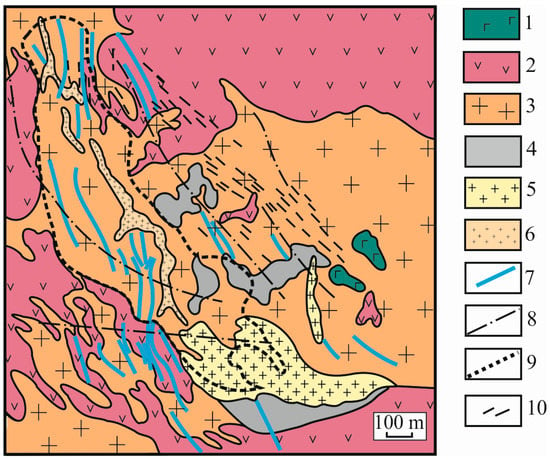
Figure 2.
Geological map of the Sora deposit: 1—gabbro, monzogabbro, syenogabbro (Kogtakh complex); 2—syenodiorite, syenite, granodiorite, diorite, monzonite (Martaiga complex); 3—leucogranite, aplite (Tygertysh complex); 4—K-feldspar metasomatites; 5–6: Ore-bearing porphyry complex, 5—granite porphyries I, 6—granite porphyries II; 7—barren dikes; 8—faults; 9—contour of the breccia ore; 10—quartz-molybdenite veins.
The gabbroid Kogtakh complex is represented by gabbro, monzogabbro, and syenogabbro, located mainly in the marginal part of the pluton in the form of large xenoliths within granitoids. The Martaiga complex is composed of syenodiorites, syenites, granodiorites, granosyenites, diorites, and monzonites. The Tygertysh complex is represented by leucogranites and aplites. Minor Mo–Cu mineralization in skarns is associated with the Martaiga complex. Stockwork and lenticular quartz-K-feldspar metasomatic bodies accompanied by disseminated molybdenite-chalcopyrite mineralization are related to the Tygertysh complex.
The major mineralization is related to the emplacement of a porphyritic complex including monzodioriteic, dioritic, granosyeniteic, and granitic porphyries. The occurrence of numerous barren Devonian dikes marked the end of the magmatic activity in the Sora ore district. The dikes are surmised to have formed as roots of the riftogenic intra-plate effusives that fill the Minusa Basin [89]. This fact probably indicates that the porphyries were formed during a transitional period from orogeny to rifting [80]. The Sora deposit is related to the junction of a sublatitudal and NW-trending tectonic zones. The latter controls the emplacement of breccia ore, and the occurrence of most quartz–molybdenum veins, porphyry dikes, and numerous barren Devonian dikes.
Two temporally separate pulses of ore-bearing magmatism related to porphyries I and II are established at the Sora deposit. Major mineralization occurred after the emplacement of porphyries I, which is represented by disseminations, stockwork, and breccia ores. The stockwork ore is the most valuable economically. The breccia ore consists of intense K-feldspar- and albitite-altered angular fragments of hosting rocks cemented by quartz-fluorite matrix containing molybdenite (two generations), pyrite, and chalcopyrite. Mo contents in the breccia ore are in the range of 0.5%–1%. Quartz-fluorite-galena-sphalerite veinlets hosted in sericitite- and pyrite-altered rocks are final products of mineralization. Thin quartz-fluorite-pyrite and quartz-molybdenite veinlets were formed after the emplacement of porphyries II.
The Cu grade is highest at the central zone of ore deposit and decreases outwards, whereas Mo content remains relatively stable. The Cu/Mo ratio decreases with depth, but within the root levels of the deposit, it increases again as Mo content drops sharply. A vertical extent of mineralization in the center is about 1000 m, varying at the flanks from 300 to 500 m. Further down the mineralization pinches out and forms separate zones.
Sotnikov et al. [55] reported 40Ar/39Ar ages for the monzonitic rocks (Kogtakh complex) as 480–460 Ma, for the leucogranites (Tygertysh complex) as 440–420 Ma, the preore dikes as 405–402 Ma, and the ore-bearing porphyries as 389–388 Ma. The Re–Os ages for Mo mineralization at the Sora deposit are significantly older [94] than those suggested by 40Ar/39Ar dating. Re–Os dating at Sora indicates two distinct periods of mineralization at about 505 Ma and 470 Ma, respectively. The younger Ar–Ar ages may reflect the later magmatic overprint. Therefore, new U–Pb isotopic dating is required to constrain the age of magmatic events related to the generation of the Sora deposit.
4.2. Aksug Porphyry Cu Deposit
The Aksug (Ak-Sug, Aksugskoye) deposit is one of the largest porphyry copper deposits in Russia discovered in 1952. The preliminary exploration and evaluation was operated from 1982 to 1985. For about 20 years, the exploration work was not active, as the region is difficult to access by conventional means. In 2012, SPK Consulting indicated mineral resources of 236 Mt of ore with 0.67% Cu, 0.18 g/t Au, 0.019% Mo, and 0.29 g/t Re and inferred resources of 486 Mt of ore with 0.37% Cu, 0.07 g/t Au, 0.008% Mo, and 0.16 g/t Re [95]. The Aksug ores locally show elevated platinum group elements contents (Pt + Pd) with the occurrence of Pd mineralization [96,97].
The Aksug deposit is situated within the Khamsara structural zone in the northeastern part of Tuva republic (Russia) within East Sayan mountains (Figure 1). This zone is bordered by sub-lateral deep strike-slip faults in the north and in the south. The Aksug pluton and associated porphyry Cu mineralization are located in the Tuvinian terrane. The Tuvinian terrane is comprised of an island-arc complex, including Early Cambrian low Na subalkaline basalts, andesites, and rhyolites, which were intruded by Middle Cambrian collisional-related subalkaline granitoids [80]. Granitoids of the collisional stage (Tannu-Ola series), comprising the giant Khamsara pluton (4500 km2), belong to the diorite-tonalite-plagiogranite formation. The pluton is mainly composed of quartz diorites and tonalites, whereas diorites and gabbro are rare (Figure 3). The ore-bearing Aksug porphyry series is confined to the Kandat deep fault and includes stocks and dikes of sodic, calc-alkaline diorites, tonalites, plagiogranites, and gabbrodiorite porphyries. The Aksug granitoid pluton is located near the Dashtyg-Oy depression composed of Devonian volcano-sedimentary rocks. The contact between magmatic rocks of the Aksug pluton and volcano-sedimentary rocks of Dashtyg–Oy depression is tectonic.
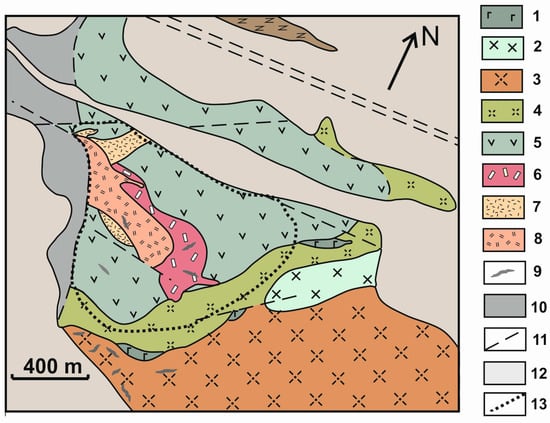
Figure 3.
Geological map of the Aksug deposit (modified after Dobryanskiy et al. [41]). 1–5: The Tannu-Ola series; 1—gabbro; 2—diorite; 3—pyroxen-hornblende quartz diorite; 4—hornblende quartz diorite; 5—tonalite; 6–8: the Aksug porphyry series, 6—porphyry tonalite; 7—granodiorite porphyry I; 8—granodiorite porphyry II; 9—the granite-aplite series: dikes of granodiorite, granite, aplite; 10—the Lower Devonian volcano-sedimentary series; 11—recent sediments; 12—faults; 13—ore zone.
The orebody resembles a truncated asymmetric cone with a barren quartz core. The stockwork mineralization is confined to a porphyry stock and is localized in quartz-sericite altered rocks. The commercial vein-stockwork and disseminated copper-molybdenum mineralization is related to the granodioritic porphyries. Low-grade (0.1% to 0.2% Cu, ~0.003% Mo) molybdenite-pyrite-chalcopyrite mineralization is related to the granodioritic porphyries of stage I. Emplacement of a second generation of granodioritic porphyries (stage II) resulted in high-grade chalcopyrite-bornite-molybdenite ore (0.3% to 1.0% Cu; 0.01–0.02% Mo) by superimposition onto the low-grade proto-ore. A general time sequence of mineral assemblages at the Aksug deposit is as follows: (1) quartz-pyrite with hematite; (2) quartz-molybdenite with pyrite and chalcopyrite; (3) quartz-chalcopyrite with bornite, pyrite, and molybdenite; (4) polysulfides with fahlore, enargite, galena, and sphalerite; (5) quartz-calcite.
The emplacement of the Aksug series was followed by taphrogenic magmatism, represented by the formations of trachybasalt-trachyrhyolite volcanic rocks and subalkaline leucogranite intrusions [44]. Granodiorite, granite, and aplite form dikes and small intrusions, which intersect at the porphyry rocks. The weak pyrite-chalcopyrite mineralization is related to granite-aplite association.
Sotnikov et al. [98] reported 40Ar/39Ar ages for amphiboles from the plutonic suite (gabbro, diorites, quartz diorites) ranging from 497 to 462 Ma and for plagioclase from granodiorite porphyry I as 403.7 ± 6.7 Ma. However, molybdenite Re–Os dating yielded a large discrepancy in Re–Os versus 40Ar/39Ar ages [94]. Re–Os ages of molybdenite from Aksug (511 ± 2 Ma) from one sample and replicates of 516 ± 2 and 518 ± 2 Ma from another sample are all significantly older than the 40Ar/39Ar ages for ore-bearing porphyries and even the precursor plutonic rocks that host ore-bearing porphyries and Cu–Mo mineralization. Several high-resolution SHRIMP U–Pb zircon ages, recently obtained from the Aksug rocks [56], provide further constraints on the time of formation of the deposit. Quartz diorite from plutonic suite of Aksug has a SHRIMP zircon age of 504.1 ± 5.2 Ma, which is relatively close to the 40Ar/39Ar age of 497 ± 1 Ma for diorite reported by Sotnikov et al. [98]. SHRIMP zircon dating of the ore-bearing porphyry suite yielded ages of 500.4 ± 5.9 and 499.2 ± 6.3 Ma for granodioritic porphyries of stage I and II, respectively. These ages disagree with the previous 40Ar/39Ar age for the porphyry series by being significantly older. However, the molybdenite Re–Os ages are older than the one for newly dated porphyry intrusions. At the same time, the U–Pb zircon ages of the Aksug rocks are consistent with those recently reported for the rocks in the Kyzyk-Chadr porphyry Cu–Mo deposit, located ~200 km SW from the Aksug and occurring in a similar geotectonic setting [42]. According to Gusev et al. [42] the U–Pb SHRIMP zircon age for Kyzyk–Chadr granite that was intruded by porphyry is 508 ± 7 Ma, and for the ore-bearing quartz diorite porphyry and the granodiorite porphyry is 507 ± 2 and 490 ± 4 Ma, respectively. In spite of some discrepancies between Re–Os and the new U–Pb ages for the Aksug deposit, they show that the deposit was formed in the Cambrian period, not in the Early Devonian as previously thought.
4.3. Erdenetiin Ovoo Porphyry Cu–Mo Deposit
The Erdenetiin Ovoo is one of the largest Cu–Mo porphyry deposits in Mongolia, with estimated metal reserves calculated in 1991 of 7.6 Mt Cu and 216,600 t Mo in approximately 1490 Mt of ore with 0.509% Cu and 0.015% Mo [49]. The Erdenetiin Ovoo deposit is located in the territory of Northern Mongolia (Figure 1), within the Orkhon-Selenge volcano-sedimentary trough of magmatic belt, which is characterized by Late Palaeozoic to Mesozoic calc-alkaline volcanism. The Precambrian and Early Paleozoic basement rocks were intruded by the Late Permian Selenge plutonic complex. The Selenge plutonic complex is composed of rocks ranging from gabbros to leucogranites, with a predominance of granodiorites and granosyenites (Figure 4). Early Triassic porphyry complex subsequently intruded the Selenge plutonic complex. The ore-bearing porphyry complex is dominated by dioritic and granodioritic porphyries.
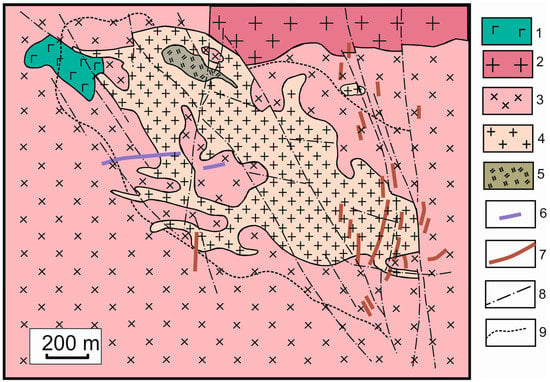
Figure 4.
Geological map of the Erdenetiin Ovoo deposit (modified after [99]). The Selenge complex: 1—gabbro; 2—granosyenite; 3—granodiorite; porphyry complex: 4—diorite porphyry, granodiorite porphyry; postore dikes: 5—felsite; 6—monzodiorite porphyry; 7—andesite and trachyandesite porphyry; 8—faults; 9—ore zone.
The orebody of Erdenet deposit extends over an area of 2 × 1 km, with a maximum vertical thickness of 560 m, including a 100 to 300 m-thick of secondary Cu enriched supergene zone at the top [100]. Porphyry Cu–Mo mineralization is most closely related to dioriteiic and granodioritic porphyries. Ore minerals consist of chalcopyrite, pyrite, molybdenite, and traces of sphalerite, tetrahedrite, and hydrothermal rutile. The deposition sequence of mineral assemblage is as follows: (1) quartz-pyrite; (2) quartz-pyrite-molybdenite with chalcopyrite; (3) quartz-pyrite-chalcopyrite; (4) quartz-pyrite-galena-sphalerite with fahlore; (5) chalcedony with rare carbonate and anhydrite [101]. Quartz-sericite alteration is predominant at the deposit, while potassic and chloritic alterations are weak.
40Ar/39Ar dating for the Erdenetuin Ovoo rocks yield ages of 259 ± 3 and 247 ± 4 Ma for granodiorite and granosyenite from the Selenge complex [102]. The SHRIMP and LA-ICP-MS zircon U–Pb data for quartz–diorite and granodiorite gave ages in the range 240–247 Ma [103]. The porphyry series showed 40Ar/39Ar ages of 235 ± 2, 225 ± 1 and 220 ± 6 Ma [102]. Replicated Re–Os analyses of molybdenite yield ages of 240.7 ± 0.8 and 240.4 ± 0.8 Ma [100]. Jiang et al. [103] reported a Re–Os isochrones age of 241.0 ± 3.1 Ma for molybdenite.
4.4. Zhireken Porphyry Mo–Cu Deposit
The Zhireken deposit was discovered in 1958 and explored from 1959 to 1967. The deposit has been mined since 1986. The estimated metal reserves calculated in 1968 were 88 Kt Mo with a Mo grade of 0.1% and 66 Kt Cu with a Cu grade of 0.068% [104]. The Zhireken Mo–Cu porphyry deposit is located within the eastern segment of Central Asian Orogenic Belt, bordering the northern margin of the Mongol–Okhotsk suture zone (Figure 1). The deposit includes two magmatic complexes: the precursor plutonic and the ore-bearing porphyry complexes (Figure 5). Mineralization is temporally and spatially associated with granitic porphyry stocks, which intruded the Middle Jurassic (J2) granitoids of the plutonic complex.
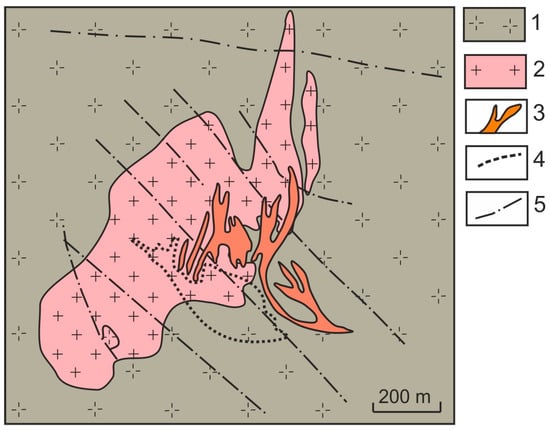
Figure 5.
Geological map of the Zhireken deposit. Plutonic series: 1—granite; ore-bearing series: 2—leucogranite; 3—granite porphyry; 4—mineralized stockwork; 5—faults.
The plutonic and porphyry complexes at Zhireken are represented by a series of high-K calc-alkaline rocks similar in composition. The plutonic complex is dominated by coarse-grained biotite granite and fine-grained leucogranite, along with trace gabbro. The subvolcanic porphyry complex mainly consists of a granitic porphyry with subordinate monzonitic and quartz monzonitic porphyries. Mafic rocks are rare and occur mainly as remnants among the granitoid rocks. Both plutonic and porphyry complexes include adakite-like rocks with geochemical characteristics of K-adakites associated with high-K calc-alkaline granitoids with typical arc-type characteristics.
Recent studies of geology and geotectonics of Eastern Transbaikalia [75,91] together with geochronological data [46,53] are consistent with the emplacement of plutonic complex at the final stage of the collisional regime in the region; the formation of porphyry complex may have been overlapped with a tectonic setting transited to extension.
The intrusion of Zhireken pluton has been dated at 188–168 Ma (40Ar/39Ar dating; amphibole), the porphyritic stock at 160–158 Ma (40Ar/39Ar dating; K-feldspar) by Ponomarchuk et al. [46]. SHRIMP U–Pb zircon dating yielded ages of 164–161 Ma for the intrusion of Zhireken pluton, while the porphyry complex showed ages of 161 ± 1.6 and 157.5 ± 2.0 [52]. The Re–Os dating of molybdenite of three different samples from Zhireken deposit are 162 ± 1, 163 ± 1, and 163 ± 1 Ma [94].
4.5. Shakhtama Porphyry Mo Deposit
The Shakhtama porphyry Mo deposit is located at Eastern Transbaikalia (Russia) within the Shakhtama granitic pluton (135 km2), bordering the southern margin of the Mongol–Okhotsk orogenic belt (Figure 1 and Figure 6). The deposit is medium in size, with ~50 Kt Mo resources with a grade of 0.1% Mo and ~50 Kt Cu resources with a grade of 0.1% Cu [53,101]. The Shakhtama pluton is hosted within the Permian Unda granitoid complex [105] and terrigenous sediments (J1). The multiphase Shakhtama pluton is composed of rocks ranging from monzodiorite to granite in composition. Porphyry rocks are dominated by quartz monzonite and granite porphyries that intruded into the precursor of the multiphase Shakhtama pluton. The porphyries belong to the high-K calc-alkaline and shoshonitic series.
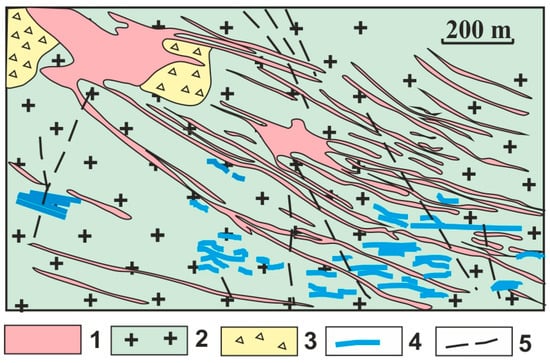
Figure 6.
Geological map of the Shakhtama deposit. 1—Shakhtama series: granite, granosyenite, granodiorite, monzonite, gabbro; 2—Ore-bearing porphyry series: granite, granodiorite, monzonite porphyry; 3—explosive breccia; 4—quartz-molybdenite veins; 5—faults.
Geological features [90,91] and geochronological data [47,60,94] show that the Shakhtama pluton was intruded synchronously with the final stage of the collisional tectonics in the region. The age of ore-bearing porphyry complex is contemporaneous with the Late Jurassic transition from collisional to extensional tectonics, when a number of rift basins filled with thick volcanic and terrigenous sediments started to form in the region [83,106]. Voluminous Mesozoic granitoid batholiths occur within the NE-trending zone, while the late Mo-bearing porphyry dikes distribute along the NW-trending extensional structures stretching over a few tens of kilometers. The molybdenum mineralization is represented by quartz-molybdenite veins, containing pyrite and rare chalcopyrite; this is genetically related to the emplacement of shallow level porphyritic intrusions.
The intrusion of the Shakhtama pluton has been dated at 169–165 Ma and the porphyry complex at 161–156 Ma (40Ar/39Ar dating; amphibole) [47]. Recent SHRIMP U–Pb zircon dating yielded ages of 163–159 Ma for the plutonic complex, while the porphyry complex showed ages of 160–153 Ma. The Re–Os age for two molybdenite samples from the Shakhtama deposit is in the range of 160–157 Ma [94].
5. Analytical Methods
Major and trace elements. Major element compositions of whole-rock samples were determined using VRA-20R X-ray fluorescence at the Analytical Centre of the Institute of Geology and Mineralogy, Novosibirsk, Russia. The analytical errors were generally less than 5%. Trace elements (including rare-earth elements) were analyzed by inductively coupled plasma mass spectrometry (ICP-MS, Element, Finnigan MAT) at the Analytical Centre of the Institute of Geology and Mineralogy, Novosibirsk, Russia. The uncertainty of the analyses is generally 2%–7%. The details of the analytical procedures were as described in [60]. The contents of trace elements in a few samples from Sora and Erdenetiin Ovoo deposits, presented in Table 1, were determined by X-ray fluorescence analysis (Rb, Sr, Zr, Nb, and Y), atomic absorption spectroscopy (Ba and Cs), and the neutron activation method (other elements) at the Analytical Centre of the Institute of Geology and Mineralogy, Novosibirsk, Russia.

Table 1.
Major and trace elements for representative samples from the porphyry Cu–Mo and Mo–Cu deposits within the southern margin of the Siberian craton.
Whole-rock Sr and Nd isotopes. Strontium isotopic analyses were performed on an MI 1201AT solid mass spectrometer at the Analytical Centre of the Institute of Geology and Mineralogy, Novosibirsk, Russia, using analytical procedures as described in [52]. Samarium and neodymium isotope analyses were performed at the Laboratory of Geochronology, Geological Institute of Kola Scientific Center of the Russian Academy of Sciences (Apatity) on a multi-collector Finnigan MAT-262 (RPQ) thermal ionization mass spectrometer, operating in static mode. The precision for Sm, Nd, and 147Sm/144Nd was ±0.2% (2σ). The details of the analytical procedures were as described in [52].
Zircon U–Pb dating. U–Pb isotopic analyses were performed using the Sensitive High-Resolution Ion Microprobe (SHRIMP-II) at the All Russia Geological Research Institute (VSEGEI, St. Petersburg, Russia). The data were processed with Ludwig SQUID1.0 and ISOPLOT programs. Instrumental conditions and analytical details were as described in [52,60].
40Ar/39Ar dating. 40Ar/39Ar dating was performed on rock-forming minerals (amphibole, biotite, and feldspars) at the Analytical Centre of the Institute of Geology and Mineralogy, Novosibirsk, Russia, using an MI-1201B mass spectrometer. Analytical procedures are similar to those described in [55].
6. Geochemical Characteristics
The major and trace element compositions of representative rock samples from the causative intrusions are presented in Table 1. In this section, we present a brief description of geochemical characteristics of the samples from these intrusions. A more complete dataset and description of rock compositions were reported in recent publications [48,50,52,53,60,107,108]. The plutonic and porphyry rocks from the intrusions associated with porphyry Cu(Mo) and Mo(Cu) deposits along with the southern margin of the Siberian craton display a relatively wide compositional range with low to high silica contents, varying from ~47 to ~75 wt %.
Aksug. The Aksug magmatic rocks have moderate alkalis with Na2O + K2O varying from 3.84 to 7.52 wt %. Most of the Aksug samples fall within the field of tholeiitic affinity on the SiO2 vs. alkali diagram (Figure 7A). In the K2O–SiO2 diagram, the Aksug samples plot predominantly within the calc-alkaline field (Figure 7B). The contents of lithophile elements are relatively low with Sr varying from 85 to 830, Rb from 10 to 110, Ba from 80 to 1200, and La from 6 to 16 ppm. The samples show depleted HFSE (high field strength element) contents and REE (rare earth element) contents, varying from 35 to 110 and from 35 to 160 ppm, respectively.
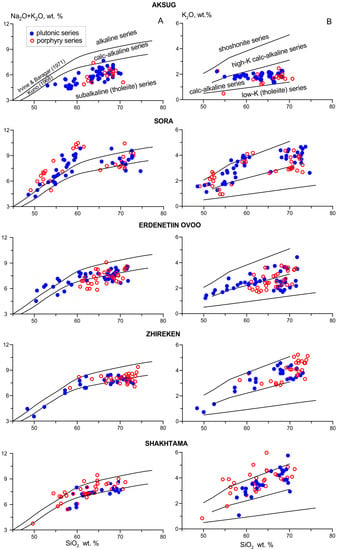
Figure 7.
Alkalis vs. SiO2 diagram (A) with boundaries between the alkaline and subalkaline (tholeiitic) fields (after Irvine and Baragar [109] and Kuno [110]) and K2O vs. SiO2 diagram (B) using the classification of Peccerillo and Taylor [111] for plutonic and porphyry rocks from the Aksug, Sora, Erdenetiin Ovoo, Zhireken, and Shakhtama deposits.
Sora. The Sora samples have relatively higher total alkalis ranging from 3.96 to 10.57 wt %. In the (K2O + Na2O)–SiO2 diagram, most of the Sora samples plot within the alkaline and calc-alkaline field. In the K2O-SiO2 diagram, most of the samples lie within high-K alkaline and calc-alkaline fields (Figure 7B). The samples show relatively high contents of lithophile elements with Sr up to 2100 ppm, Rb up to 160, Ba up to 1700, and La up to 80 ppm. The REE and HFSE contents range from 120 to 400 ppm and from 115 to 315 ppm, respectively.
Erdenetiin Ovoo. The Erdenetiin Ovoo samples show total alkali content varying from 4.63 to 9.52 wt %, with plots in the field of calc-alkaline and tholeiite series in the (K2O + Na2O)–SiO2 diagram (Figure 7A); in the K2O–SiO2 diagram, the samples lie within high-K alkaline and calc-alkaline fields (Figure 7B). Porphyry and plutonic rocks contain Sr up to 1000, Rb up to 100, Ba up to 1500, and La up to 25 ppm. The REE and HFSE contents range from 40 to 370 ppm and from 70 to 510 ppm, respectively.
Zhireken and Shakhtama. The plutonic and porphyry rocks from Zhireken and Shakhtama deposits show variable SiO2 contents ranging from 48.4 to 78 wt %. However, mafic rocks are rarely present at Zhireken and Shakhtama Mo(Cu) porphyry deposits compared with previously described Aksug Cu porphyry, the Sora Mo–Cu porphyry, and the Erdenetiin Ovoo Cu–Mo porphyry deposits. The Zhireken and Shakhtama granitoids show total alkali contents ranging from 3.55 to 9.46 and 3.99 to 10.24 wt %, respectively. Most of the Zhireken and Shakhtama samples plot within calc-alkaline field on the SiO2 vs. alkali diagram (Figure 7A). In the K2O–SiO2 diagram (Figure 7B), all samples from the Zhireken deposit and most samples from the Shakhtama plutonic series plot in the high-K calc-alkaline field, while samples from the Shakhtama porphyry series belong to both high-K calc-alkaline and shoshonite series.
More detailed data on chemical composition of mafic, intermediate, and felsic intrusive rocks from the causative deposits are provided and discussed below.
7. Petrogenesis and Sources of Magmas
Porphyry Cu(Mo) and Mo(Cu) mineralization that occurred within the southern margin of the Siberian craton include two groups of deposits: (1) deposits that were formed from the Early Paleozoic to Late Paleozoic–Early Mesozoic in accretion-collision zones along the margin of the Siberian continent (Aksug porphyry Cu, Sora porphyry Mo–Cu, and Erdenetiin porphyry Cu–Mo); and (2) deposits that formed in the collision zone of Siberian and North China–Mongolia continents during the Mesozoic (Zhireken porphyry Mo–Cu and Shaktama porphyry Mo).
7.1. Paleozoic–Early Mesozoic Deposits
7.1.1. Geochemistry of Mafic Rocks
Aksug. The gabbroic rocks from both plutonic and porphyry suites from the Aksug deposit are calc-alkaline and characterized by relatively low SiO2 (from 50.35 to 54.12 wt %), TiO2 (average 0.94 wt %), MgO (average 4.71 wt %), Mg# (average 43), and high Al2O3 (average 17.61 wt %). They have K2O/Na2O with an average of 1. The contents of compatible elements are low (Ni < 21, Cr < 25 ppm). The contents of Rb, Sr, and Ba are lower than 100, 600, and 500 ppm, respectively. The gabbroic rock show depleted total REE contents, ranging from 34 to 62 ppm.
Sora. The gabbroic rocks of Sora deposit are high-K calc-alkaline with SiO2 contents ranging from 48.85 to 53.3 wt %. They are enriched with MgO (average 6.19) and TiO2 (average 1.50 wt %), and show elevated Mg# values (52) relative to the Aksug gabbroic samples. They are characterized by significantly lower K2O/Na2O ratios (0.44) compared to the Aksug, and elevated Ni and Cr contents ranging from 20 to 133 and from 56 to 442 ppm, respectively. The Rb contents are low (<70 ppm), while Sr and Ba are highly variable in contents, ranging from 517 to 2333 and from 305 to 2100, respectively. The average total REE content in gabbro is 172 ppm and in gabbro porphyry is 216 ppm.
Erdenetiin Ovoo. The gabbroic samples from Erdenetiin Ovoo are calc-alkaline to high-K calc-alkaline, and they show SiO2 abundances ranging from 50.60 to 53.95 wt %. Average TiO2 (1.16 wt %) and MgO (5.75 wt %) contents are lower relative to the Sora gabbroic rocks, but higher compared with the Aksug mafic samples. Trace elements contents are generally comparable to those from Sora mafic samples. The gabbro and gabbroic porphyries show average Ni of 31 and 95 ppm, Cr of 278 and 178 ppm, Rb of 39 and 17ppm, Sr of 998 and 1484 ppm, Ba of 441 and 678 ppm, and total REE of 178 and 123 ppm, respectively.
7.1.2. Origin of Mafic Rocks
Rocks of porphyry Cu–Mo and Mo–Cu deposits from the Altai-Sayan segment and Northern Mongolia show positive εNd(t) values and (87Sr/86Sr)i ratios close to the mantle values (Table 2). εNd(t) and (87Sr/86Sr)i values were calculated to the age of rock formation from U–Pb zircon and 40Ar/39Ar dating [55,56,102]. In the εNd(t)–(87Sr/86Sr)i diagrams, the Sr and Nd isotope compositions of the deposits lie close to the mantle array (Figure 8A–C). The εNd(t) and (87Sr/86Sr)i values for igneous rocks of Aksug are +8.0–+6.1 and 0.7011–0.7035, respectively. The estimated Nd model ages TNd(DM1st) for Aksug is 0.57–0.85 Ga. The rocks from the Sora and Erdenetiin Ovoo deposits show lower εNd(t) values and slightly higher (87Sr/86Sr)i ratios. The εNd(t) and (87Sr/86Sr)i values of the Sora samples range from +3.4 to +0.3 and from 0.7040 to 0.7046, respectively. The Erdenetiin Ovoo rocks show εNd(t) ranging from +4.1 to +1.5 and (87Sr/86Sr)i ranging from 0.7041 to 0.7047. The estimated TNd(DM1st) ages for the rocks of the Sora and Erdenetiin Ovoo deposits are 0.79–1.11 and 0.65–0.98 Ga, respectively. Low (87Sr/86Sr)i ratios and positive εNd(t) values in these mafic rocks indicate that their parental magmas were likely derived from mantle.

Table 2.
Summarized isotopic and geochronological data for the plutonic rocks and ore-related porphyries from representative porphyry Cu(Mo) and Mo(Cu) deposits of the southern margin of the Siberian craton.
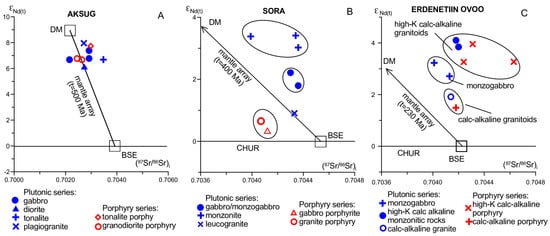
Figure 8.
Diagram of εNd(t)–(87Sr/86Sr)i for magmatic rocks from the Aksug (A); Sora (B) and Erdenetiin Ovoo (C). The initial Sr and Nd isotopic ratios have been calculated at the ages based on U–Pb and 40Ar/39Ar dating [55,56,102].
Typical arc magma characteristics for the Aksug, Sora, and Erdenetiin Ovoo samples such as the enrichment in large-ion lithophile elements (LILE) and light rare-earth elements (LREE), depletion in heavy rare-earth elements (HREE) and high-field-strength elements (HFSE) and negative Nb, Ta, and Ti anomalies (Figure 9A,B) indicate that magmas parental for these mafic rocks were derived from a lithospheric mantle previously metasomatized by slab fluids/melts. High Ba contents relative to Th support mantle enrichment by slab-derived fluids for the magmas of mafic rocks at Aksug, Sora, and Erdenetiin Ovoo deposits. Low La, Ce, Zr, and Hf (<10 ppm) contents in Aksug mafic rocks and their elevated contents in Sora and Erdenetiin Ovoo (>10 ppm) point to a more depleted mantle source for porphyry Cu-rich Aksug deposit relative to the Sora and Erdenetiin Ovoo deposits with higher molybdenum proportion in ores. Relatively low contents of compatible elements in gabbroic samples suggest their petrogenesis via crystal fractionation of mantle-derived melt.
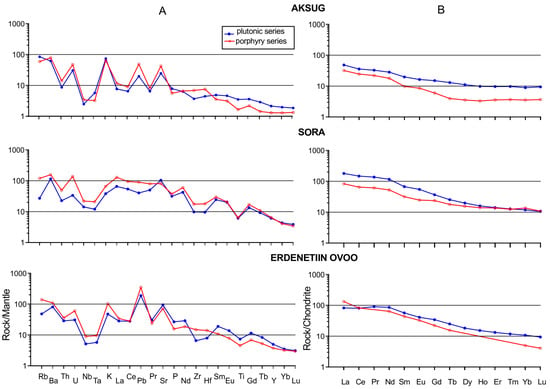
Figure 9.
Diagram of primitive-mantle normalized trace elements patterns (A) and chondrite-normalized REE patterns (B) for typical mafic samples from the Aksug, Sora, and Erdenetiin Ovoo. Primitive mantle and chondrite normalizing values are after McDonough and Sun [112].
According to the Sr–Nd isotopic data, the Aksug gabbro show depleted signatures with a high εNd(t) of +6.7–+7.4 and a low (87Sr/86Sr)i of 0.7022–0.7029 (Figure 8A), suggesting that the magma originated from a depleted mantle. The initial Sr isotopic and Nd ratios of the Sora gabbro range from 0.7043 to 0.7044 and from +1.8 to +2.2, respectively. The Sora gabbro porphyry yield εNd(t) of +0.7 and (87Sr/86Sr)i of 0.7041. The Erdenetiin Ovoo gabbro yield a εNd(t) value and a (87Sr/86Sr)i value of +2.7 to +3.2 and of 0.7041 to 0.7041, respectively. Postore basalt dykes show εNd(t) ranging from +2.2 to +2.5 and (87Sr/86Sr)i ranging from 0.7042 to 0.7043. In summary, Sr and Nd isotopic data for the Sora and Erdenetiin Ovoo mafic samples suggest that the protolith magmas were sourced from a moderately enriched mantle.
REE patterns display gentle slope from Gd to Lu for mafic rocks from Aksug and steep slope for the Sora and Erdenetiin Ovoo gabbroic rocks (Figure 9B). Relatively low (Tb/Yb)n ratios (<1.8) in the most primitive samples from Aksug are likely attributed to residual spinel in the source [113]. The higher (Tb/Yb)n ratios (>1.8) observed in mafic rocks from Sora and Erdenetiin Ovoo suggest that their magmas were formed in the presence of residual garnet. The TDM model ages for gabbroic rocks from Aksug of ~0.8 Ga and Sora of ~1 Ga correspond to the Paleo-Asian Ocean opening [114].
7.1.3. Geochemistry and Origin of Granitoid Rocks
Granitoid samples from Aksug, Sora, and Erdenetiin Ovoo deposits are characterized by a certain similarity in petrogeochemical composition, alkalinity, trace element content, and Sr isotopic composition with their precursor mafic rocks. They show enrichment in LREE and depletion in HREE with positive Pb, Sr, and negative Nb, Ta, and P anomalies. Similar to mafic rocks, granitoid samples from the Aksug are depleted in lithophile trace elements relative to the Sora and Erdenetiin Ovoo granitoid samples.
Aksug. Sr–Nd isotopic characteristics (Figure 9A, Table 2) suggest a significant contribution of mantle material in the formation of granitoid magmas at Aksug. Mafic and granitoid samples show relatively similar geochemical characteristics and overlapping initial Sr and Nd compositions. Diorites have REE patterns with a gentle slope, moderately enriched in LREEs with negative Eu anomaly (Figure 10), low (La/Yb)n (<10), Sr/Y (<20) ratios and relatively high Yb (>1.8 ppm) and Y (>18 ppm) contents, indicating an absence of residual garnet, considerable residual plagioclase in the source magma, or fractionation during magmatic evolution. Consequently, it can be inferred that the diorites were originated under low-pressure conditions.
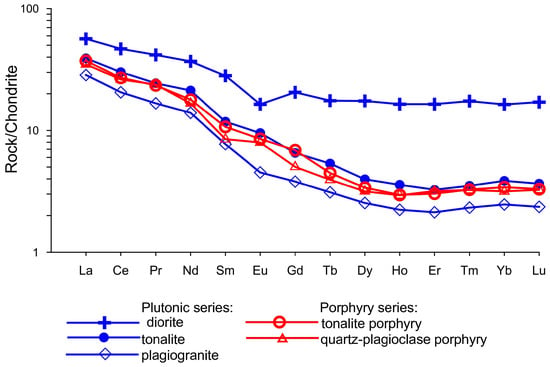
Figure 10.
Diagram of chondrite-normalized REE patterns for typical rocks of felsic and intermediate compositions from Aksug deposit. Chondrite normalizing values are after McDonough and Sun [112].
The Aksug tonalite-plagiogranite rocks from plutonic and porphyry suites show adakite-like geochemical signatures. They have low Y (3.9–6.7 ppm) and Yb (0.40–0.69 ppm) contents and elevated Sr/Y (38–152) and (La/Yb)n (10–23) values. Chondrite-normalized REE patterns show a lack of Eu anomalies and steep slopes (Figure 10). Partial melts of a deep (>40 km) basaltic source will have the high Sr/Y and La/Yb ratios and low Y and Yb contents seen if both garnet and amphibole but not plagioclase are residual in the source. The coeval occurrence of contrasting high-pressure indicators suggests that the Aksug quartz diorite and adakitic tonalite-plagiogranite magmas were generated under different melting conditions.
A lack of correlation between εNd and MgO (Figure 11) could be interpreted as being due to partial melting/fractional crystallization without a high level of contamination/assimilation during the generation and evolution of the Aksug magmas. A lack of adakitic geochemical signatures and elevated contents of incompatible elements in diorites probably suggest their derivation via differentiation of basaltic magma in high-level magma chambers at a depth <20 km. The generation of Aksug adakitic magma is consistent with the basalt partial melting in a mafic lower crust at high pressure where garnet is stable as a residual phase. Relatively high εNd(t), ranging from +6.6 to +7.7, low Sri (0.7011–0.7029), young TDM (0.6–0.7 Ga) model ages, and adakite-like geochemical characteristics suggest that the tonalite-plagiogranite magmas may have been generated by a partial melting of a basaltic lower crustal source formed by an underplating of earlier depleted mantle-derived mafic magmas. Similar geochemical signatures and Sr–Nd isotopic compositions for the gabbroic and felsic rocks suggest their derivation from similar sources.
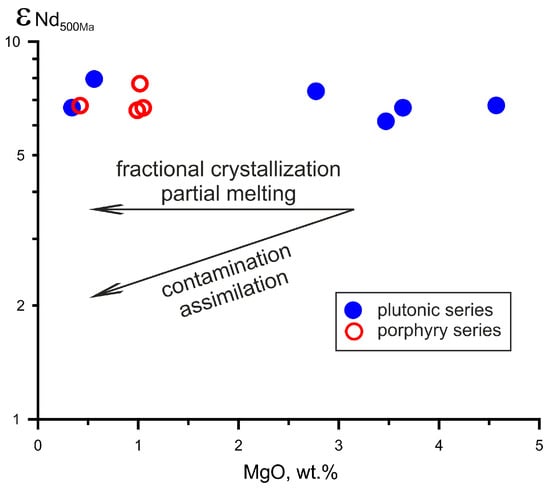
Figure 11.
Diagram of εNd(t)–MgO for magmatic rocks from the Aksug.
Sora. The composition of plutonic and porphyry rocks at Sora deposit varies from gabbros to granites with SiO2 contents ranging from 47.91 to 73.7 wt %. There is a composition gap at the interval of SiO2 ~62–65 wt %, which is inconsistent with a continuous fractionation process. The (Na2O + K2O)–SiO2 diagram for the less altered samples shows the presence of two different magmatic evolution trends (Figure 7A). The first trend evolves from gabbro to syenite, and the second from gabbro to granite. The granitoid samples with elevated K2O + Na2O contents (monzonites) form a single linear trend with the mafic rocks, while granitoid samples with lower K2O + Na2O contents (leucogranites and granite porphyries) form a group that falls on the right side of the trending line.
The monzonitic rocks show elemental geochemistry (e.g., relatively high Rb, Ba, U, Sr, La, Ce, Yb, and Lu) and Sr isotopic compositions similar to the gabbroic rocks, which indicates that the two rock suites share a similar origin. Initial 87Sr/86Sr values range from 0.7043 to 0.7044 and from 0.7043 to 0.7045 in the monzonitic rocks and gabbro/monzogabbro, respectively. The CaO, MgO, FeO, TiO2, and compatible element contents display a negative correlation with SiO2 for gabbroic to monzonitic rocks, while alkalis, Rb, Ba, and HFSE, show a positive correlation with SiO2. These facts indicate that the gabbro-monzonitic series of both plutonic and porphyry suites may have been produced by fractional crystallization of basaltic parental magma.
The presence of two trends in compositional evolution, as well as a gap in SiO2 content suggests that granites within both suites could not be interpreted as the products of fractional crystallization of monzonites. The decrease in alkalinity could not result from the feldspar fractionation, as the samples do not exhibit a pronounced negative Eu or Sr anomaly (Figure 12A,B). REE patterns with a gentle slope for monzonite and steep slope for leucogranite (Figure 12B) require the generation of melts at different depths, where residual garnet was absent/present, respectively.

Figure 12.
Diagram of primitive-mantle normalized trace elements patterns (A) and chondrite-normalized REE patterns (B) for typical granitoid samples from the Sora deposit. Primitive mantle and chondrite normalizing values are after McDonough and Sun [112].
The intermediate monzonitic rocks of the Uibat pluton (monzonite, monzodiorite, quartz monzonite) show higher εNd(t) values than the gabbro/monzogabbro: monzodiorite +3.4, monzonite +3.0, quartz monzonite +3.4. Calculated Nd model ages TDM for monzonitic rocks vary from 0.84 to 0.91 Ga. On the εNd–(87Sr/86Sr)i diagram (Figure 9B) leucogranites, granite porphyries and gabbro-porphyrites fall close to the monzogabbro of pluton, the mantle array, and the CHUR line, while monzonites are plotted aside from them. The steep REE pattern with (La/Yb)n ~23–28 and the absence of negative or negligible Eu anomalies for granitoid samples imply that the garnet was in equilibrium with the partial melt and that the source was plagioclase-free (Figure 12B). Taking into account isotopic and REE data, it is suggested that the parental melts for leucogranite and granite porphyries are not genetically related to the monzonitic magmas. They may have been derived from the partial melting of basaltic protolith (similar in composition to gabbro and gabbro porphyrite) in the deeper lower crust, where garnet was stable as a residual phase after the melting. The calculated Nd model age TDM for leucogranites and granite porphyries is 1.0 and 0.9 Ga, respectively. They are close to the Nd model ages of the gabbroic rocks, suggesting a dominant role of the mantle source in the origin of granitoid rocks.
Erdenetiin Ovoo. Like the Sora magmatic samples discussed above, Erdenetiin Ovoo rocks can be divided into two groups. Based on the K2O vs. SiO2 classification diagram, the first group belongs essentially to high-K calc-alkaline rocks evolving from gabbroic to felsic composition. The second group is represented by granitoids that fall within calc-alkaline field (Figure 7B). Both high-K calc-alkaline (monzonites and quartz monzonites) and calc-alkaline (granodiorites, granites) granitoids have similar SiO2 contents, but show distinct major element (K, Na, and Mg) and REE compositions. The high-K calc-alkaline granitoids have in general higher contents of K2O and MgO compared to the calc-alkaline felsic rocks with similar SiO2 contents. Chondrite-normalized REE diagrams show a gentle slope and negative Eu anomaly for the high-K calc-alkaline granitoits, suggesting an evolution of magma under low pressure conditions in which plagioclase was a stable mineral (Figure 13). In contrast, the calc-alkaline granitoid samples display a steeper slope of REE patterns with no Eu anomalies. These geochemical features suggest that the magma equilibrated with amphibole and garnet-bearing mineral residues. Therefore, it is reasonable to conclude that the high-K calc-alkaline and calc-alkaline melts were probably generated at different depths.

Figure 13.
Diagram of chondrite-normalized REE patterns for high-K calc-alkaline (A) and calc-alkaline (B) granitoids from the Erdenetiin Ovoo deposit. Chondrite normalizing values are after McDonough and Sun [112].
In the εNd(T)–(87Sr/86Sr)i diagram, the isotopic compositions of calc-alkaline granitoids are shifted towards gabbro, the mantle array, and the CHUR line compared to the high-K calc-alkaline monzonitic rocks (Figure 9C). The εNd(t) values for calc-alkaline leucogranite and granite porphyries are +1.9 and +1.5, respectively. The εNd(t) values for high-K calc-alkaline monzonitic samples are higher, ranging from +3.8 to +4.1 for plutonic rocks and from +3.2 to +4.0 for the porphyry samples. The calculated Nd model age TDM for the gabbroic rocks is ~0.9 Ga. The granitoids yield a εNd(t) value from 0.7 to 0.8 Ga. Thus, the REE and isotopic data suggest that the parental granitoid melts are not genetically related to the monzonitic melts. Like the Sora granitoid rocks, the calc-alkaline granitoids from Erdenetiin Ovoo were probably derived by partial melting of basaltic protolith at the bottom of lower crust. This suggestion is also supported by the plots of Erdenetiin Ovoo calc-alkaline granitoids within the adakite field on (La/Yb)n vs. Ybn and Sr/Y vs. Y discrimination diagrams (Figure 14). The most widely accepted model for generating adakitic magmas involves the partial melting of a mafic protolith, which has been transformed into either amphibolite, garnet amphibolite, or eclogite at a pressure of at least 12 kbar (corresponding to a depth of at least 40 km). High-K calc-alkaline monzonitic rocks, showing low Sr and elevated Y contents, were crystallized at a lower pressure of <8 kbar (within the plagioclase-pyroxene stability field).
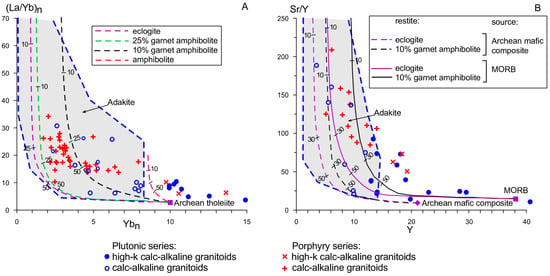
Figure 14.
Plots of (La/Yb)n versus Ybn (A) and Sr/Y versus Y (B) for the Erdenetiin Ovoo granitoids after Drummond and Defant [115].
7.2. Mesozoic Deposits
7.2.1. The Most Primitive Rocks
Zhireken. The most primitive samples at Zhireken are composed of gabbro in the plutonic series and monzonite porphyries in the porphyry series. The gabbroic samples from the plutonic series show relatively high MgO (up to 8.84 wt %), Ni, Cr, V, and Sc contents (up to 101, 216, 360 and 52 ppm, respectively), and a high Mg# value (67). The contents of Rb and Ba are low (17 and 72 ppm, respectively). They are mainly metaluminous (A/CNK = 0.64–0.75) and exhibit high-K calc-alkaline features. Trace and REE distribution diagrams for typical Zhireken rocks are presented on Figure 15A,B. In contrast to mafic samples of Paleozoic–Early Mesozoic deposits of Siberia and Mongolia discussed above, the Zhireken gabbro show a pronounced negative Ba anomaly (Figure 15A). This results in high Rb/Ba and Th/Ba (>1) ratios in gabbro, consistent with the suggestion that their precursor melts were derived from a mantle that had been metasomatized predominantly by melts [116]. A relatively low εNd(T) value (−1.4) and a (87Sr/86Sr)0 value of 0.70501 in gabbro probably imply an involvement of the crustal component in the source. Figure 16 shows an isotope correlation diagram (εNd vs. initial 87Sr/86Sr) for the Zhireken rocks. The Sr–Nd isotopic characteristics of gabbro are similar to those of enriched mantle type I. The estimated TNd(DM-1st) age for gabbro is 1.1 Ga, suggesting that the mantle source resulted from being metasomatized by the interaction with the Precambrian crust. A relatively high (Tb/Yb)n value of 1.9–2.06 in the gabbro implies that the basaltic magma was derived from a source at pressures high enough to stabilize the garnet [113].
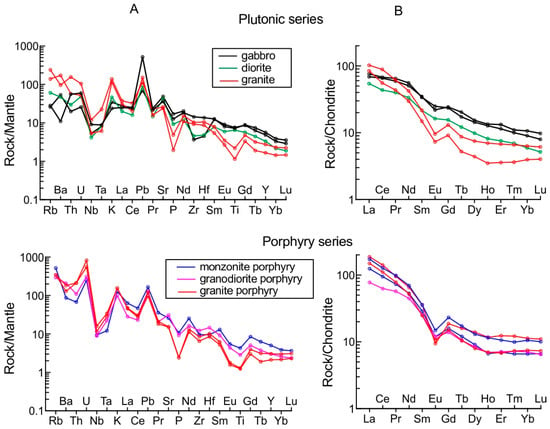
Figure 15.
Diagram of primitive-mantle normalized trace elements patterns (A) and chondrite-normalized REE patterns (B) for typical samples from the Zhireken deposit. Primitive mantle and chondrite normalizing values are after McDonough and Sun [112].
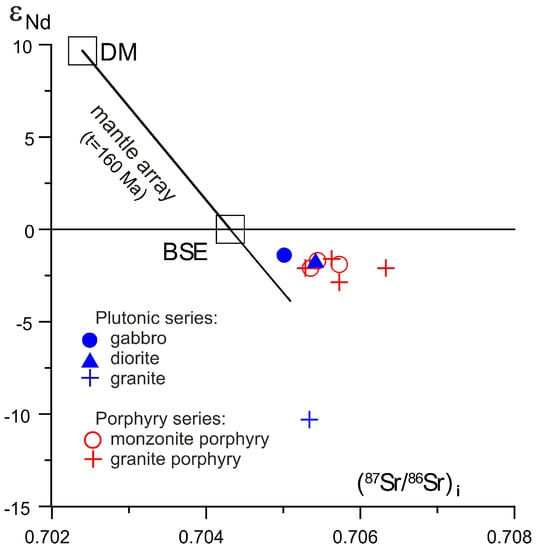
Figure 16.
Diagram of εNd(t)–(87Sr/86Sr)i for magmatic rocks from the Zhireken deposit.
Two possible mechanisms are generally assumed to account for the petrogenesis of mafic rocks with low εNd and high 87Sr/86Sr values: (1) they result from the mixing of mantle-derived and crustal melts during magma ascent [1]; or (2) they are derived from the upper mantle metasomatized by melts from deeply recycled subducted continental crust and/or a delaminated thickened lithosphere. The last model (crustal recycling) is typical of collisional zones [117,118,119]. The magmatic events at Zhireken deposit occurred during continental collision, which is favorable for crustal thickening and the subsequent mantle interaction with the foundered continental crust. Geological data suggest that the continental crust in Transbaikalia had previously been thickened by abundant calc-alkaline magmatism in an Andean-type setting on the border of the closing Mongol–Okhotsk Ocean by widespread collisional to post-collisional thrusting, and by extensive alkaline-peralkaline magmatism [120]. We therefore propose that the mantle source of gabbroic rocks from the Zhireken may have been resulted from the upper mantle metasomatized by melts from the foundered recycled lower crust.
The content of SiO2 and MgO in Zhireken gabbro-diorite is 51.60 and 4.91 wt %, respectively. The Mg# value (49) is lower than that in gabbro. The εNd(t) value for gabbro-diorite is −1.8, similar to those for the gabbroic samples (Figure 16). Contents of compatible elements (Cr and Ni) are lower while incompatible elements (Ba and Rb) are more abundant than those in the gabbro. All of these characteristics suggest crystal fractionation of mantle-derived basaltic melt for the petrogenesis of gabbro-diorite. The increased (87Sr/86Sr)i in gabbro-diorite (0.70542) relative to gabbro probably suggests some crustal contamination from derivatives of basaltic melts. Low Y (14.3 ppm) and Yb (0.95 ppm), a high Sr/Y ratio (60), and negligible Eu anomaly (Eu/Eu* = 0.88) (Figure 15B) suggest the derivation of gabbro-diorite melt in the source area at (or near) the mantle–crust boundary.
The most primitive porphyry rocks at Zhireken are monzonite porphyry. The contents of SiO2, MgO, and Mg# value in monzonite porphyry are 56.12–59.00 wt %, 4.91–5.57 wt %, and 53–55, respectively. The contents of Ni and Cr are relatively high, up to 169 and 290 ppm, respectively. The major and trace (Ni, Cr) element compositions of the monzonite porphyry resemble that of high-Mg andesites (diorites) [121,122]. The high contents of Ni and Cr in monzonite porphyry probably imply melt equilibrium with mantle olivine in the mantle source. Metasomatized mantle, as one of the possible sources, has been proposed to account for an origin as of high-Mg diorite/andesite [121]. The εNd(t) values in monzonite porphyries, ranging from −1.7 to −2.1, are slightly lower, while (87Sr/86Sr)i (0.70535) and LILE contents are slightly higher than those in gabbro (Figure 15A and Figure 16), implying a greater incorporation of ancient continental crust components in the mantle source of porphyry intrusions.
Shakhtama. The Shakhtama rocks are predominantly metaluminous, I-type high K calc-alkaline to shoshonitic in composition. The most primitive rocks at Shakhtama are diorites (SiO2 up to 57.9 wt %) and monzodiorite porphyries (SiO2 up to 54.63 wt %). A trace element spider diagram shows positive Rb, U, Th, and Pb, negative Ba, Ta, Nb, and Ti, and negligible negative Sr anomalies (Figure 17A). Diorites and monzodiorite porphyry have similar chondrite-normalized REE patterns with a negative slope, displaying high contents of LREE, lowered medium REE (MREE), low HREE, and a small negative Eu anomaly (Figure 17B). The samples show adakite-like signatures characterized by low contents of Y (13.3 and 14.5 ppm), Yb (1.13 and 1.08 ppm), high La/Yb (15 and 29) in diorite, and monzodiorite porphyry, respectively. The diorite samples show relatively high MgO (up to 8.62 wt %), a high Mg# value (69), and high compatible trace element contents: Ni (up to 197 ppm), Cr (up to 768), and V (up to 147ppm). The monzodiorite porphyry have Mg# up to 66; MgO, Ni, Cr, and V up to 9.48 wt %, 272 ppm, 498 ppm, and 145 ppm, respectively. Both diorite and monzodiorite porphyry samples are characterized by high Rb (up to 120 and 400 ppm), high Ba (up to 530 and 1100 ppm), and moderate Sr (up to 480 and 600) contents, respectively.
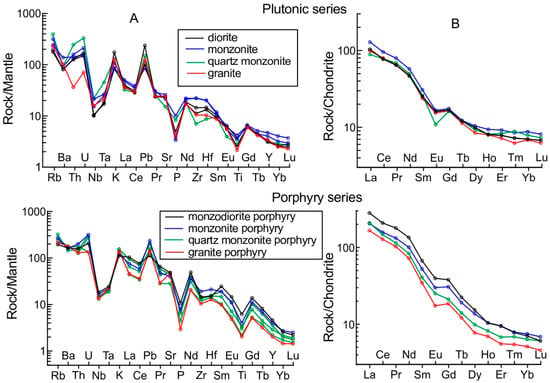
Figure 17.
Diagram of primitive-mantle normalized trace elements patterns (A) and chondrite-normalized REE patterns (B) for typical samples from the Shakhtama deposit. Primitive mantle and chondrite normalizing values are after McDonough and Sun [112].
The contents of MgO (3.42–7.12 wt %), Ni (70–260 ppm), Cr (155–429 ppm), Rb (143–346 ppm), and Ba (687–1058 ppm) in the monzonite porphyry are higher relative to monzonites from the plutonic series and lower relative to the monzodiorite porphyry. The monzonite porphyry shows a higher εNd(t) value (+2.1) and an elevated (87Sr/86Sr)i ratio (0.70765) relative to the precursor diorite, the monzonite, and the monzodiorite porphyry (Figure 18). These features indicate that the precursor plutonic rocks (diorites and monzonites) could not be the protolith for the melts parental for monzonite porphyry. Furthermore, the monzonite porphyry could not be formed by the differentiation of monzodiorite porphyritic magma. The Nd isotopic composition of monzonite porphyries is comparable to that of the juvenile crust for the magma source, formed during subduction of the Mongol–Okhotsk Ocean plate [123]. Therefore, it is reasonable to suggest the involvement of the juvenile crust, contributed by mantle-derived magmatic underplating in response to the subduction of the Mongol–Okhotsk Ocean plate and subsequent collision of Siberian and Mongolia–North China continents. The monzonite porphyry shows higher (La/Yb)n (30–48) and Sr/Y (21–46) ratios, compared to those for monzonite, suggesting the generation of porphyry magma at deeper levels.
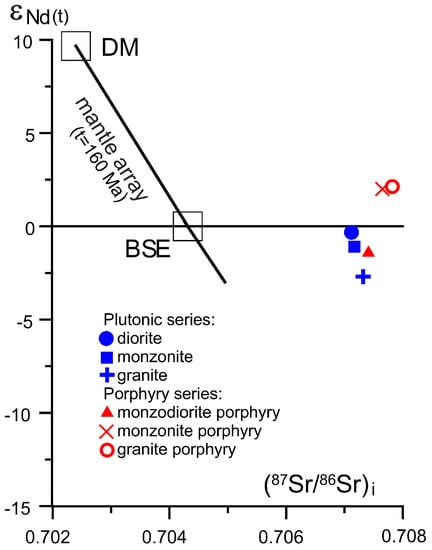
Figure 18.
Diagram of εNd(t)–(87Sr/86Sr)i for magmatic rocks from the Shakhtama deposit.
7.2.2. Granitoid Rocks
Zhireken. The granites from the plutonic series show a negative εNd(t) value of −10.3 (Figure 16) and a Nd model age of 1.5 Ga, indicating a contribution of ancient continental crustal components to their source. However, they have a relatively high Mg#, up to 48, a relatively low (87Sr/86Sr)i (0.70534) value, and trace- and rare-earth element patterns quite similar to those of the gabbroic samples (Figure 15B), implying an important role of the mantle component in their genesis. All of these features suggest that these granites were likely the result of the melting crustal components in response to the intrusion of mantle-derived mafic melts into the deep crust and the mixing between mafic mantle-derived and crustal melts. The granites display low Y and Yb contents (11.5 and 1.02, respectively), a high Sr/Y ratio (44), and a fractionated REE patterns (Figure 15B) with relatively high (La/Yb)n ratios, a low Ybn, and a weak negative Eu anomaly (Eu/Eu* ~0.6). This is consistent with the fact that the granitoid magma was generated in the lower crust and experienced plagioclase fractionation during its ascent to the upper level of the crust.
Felsic porphyry samples show εNd(t) values close to gabbro from the plutonic series, ranging from −1.6 to −2.2 (Figure 16). The strontium isotopic composition and relatively high Mg# values (30–35) in granite porphyries, as well as the quite similar trace element spidergrams and REE patterns for the granitic porphyry and mafic samples (Figure 15A,B), suggest genetic relations between felsic porphyry and mafic magmas. The Nd model age in the granitic porphyry is lower (0.7 Ga) compared with those in the granites (1.5 Ga).
The porphyry series at the Zhireken deposit include rocks of two types: (1) porphyries with adakite-like geochemical signatures and (2) porphyries with typical arc-like characteristics (Y > 18 ppm, Yb > 1.18 ppm, and Sr/Y < 30) with a relatively low Mg# (10–20) and Eu/Eu* ratio (0.35–0.40). Adakite-like rocks are characterized by elevated K2O contents and K2O/Na2O ratio of ~1. Similar K-adakitic rocks were described in orogenic units of Tibetan Plateau hosting Cu–Mo deposits [124]. Experimental data [125] have shown that K-adakitic melts can be produced by a high pressure (>20 kbar) partial melting of relatively felsic (TTG type) protolith. Adakite-like geochemical characteristics of the Zhireken porphyry rocks and Nd isotopic composition similar to those for the Zhireken mafic samples likely suggest an involvement of the juvenile crust into their source, formed by the underplating of mantle-derived basaltic magmas. The Zhireken magmas, lacking adakite-like signatures, were probably generated at a shallower level of lower crust.
The granitoid rock samples from the plutonic and porphyry series show some differences in Nd isotopic composition. Variations in the εNd(t) are probably caused by the incorporation of Precambrian crustal components in variable proportions in the magma source. The higher εNd(t) values and lower Nd model ages of the porphyry rocks relative to granites from the plutonic series imply a higher contribution of juvenile mantle-derived material to the fertile magmas of the porphyry series.
Shakhtama. The granites and granite porphyries from Shakhtama have relatively high MgO (2–4 and 1–2 wt %), Ni (up to 42 and 43 ppm), and Cr (up to 143 and 110 ppm) contents and a high Mg# (55–62 and 40–62), respectively. In addition, granitoids show similar primitive mantle-normalized incompatible element distribution patterns (Figure 17A), characterized by a significant enrichment of LILE relative to HFSE. Chondrite-normalized REE distribution patterns of the granites and granite porphyries are similar to those of the most primitive precursor rocks (Figure 17B). These features probably suggest an involvement of mantle-derived component in the petrogenesis of granitoid rocks. The granites show a lower εNd(t) value (−2.7) and an elevated (87Sr/86Sr)i ratio (0.70732) relative to the precursor high-Mg diorite. Their two-stage Nd model age is ~1.2 Ga, implying a contribution from the Precambrian source rocks. These geochemical characteristics suggest that the granite might be derived from interaction of high-Mg dioritic melts with crustal component.
The sample of granitic porphyry exhibits a εNd(t) value of +2.0, a (87Sr/86Sr)i value of 0.70782, and a two-stage Nd model age of 0.8 Ga, which is similar to those of the precursor monzonite porphyry. These geochemical characteristics suggest that granite porphyry were produced by a partial melting of the juvenile crust and/or the crystallization differentiation of the monzonite porphyry magma. Additionally, relatively high MgO, Ni, and Cr contents in granite porphyry may reflect some contribution from high-Mg mantle-derived magmas. Collectively, the Shakhtama granite porphyry was likely generated by the partial melting of the juvenile crust modified by high-Mg mantle-derived melts. Geochemical and isotopic features of Shakhtama granitic rocks imply a heterogenous crustal source in their petrogenesis including juvenile and ancient crustal components. The derivation of melts related to the formation of plutonic and porphyry rocks involved variable amounts of old lower crust and juvenile crust. Isotopic data imply a large contribution of juvenile mantle-derived material to the granitoid magmas of the ore-bearing porphyry series and Precambrian crustal components to the magma of the granites of the plutonic series.
In summary, adakite-like magmas of monzonites, granites, monzonite, and granite porphyries were probably generated near the base of the lower crust. High-Mg mantle-derived melts caused the partial melting of the continental crust. Granitoid magmas parental for the plutonic series were generated via the melting of the Precambrian crust and the interaction with high-Mg melts, while granite porphyry melts were probably generated at deeper levels by a partial melting of the juvenile crust. Monzonitic magmas may have been derived by the mixing of high-Mg mantle-derived melts with granitoid melts.
8. Conclusions
Based on the available geochronological data, three epochs of porphyry Cu–Mo mineralization can be recognized within the southern margin of the Siberian craton, i.e., Early-Middle Paleozoic, Late Paleozoic–Early Mesozoic, and Mesozoic. In general, the deposits delineate a trend of decreasing age with decreasing Cu/Mo ratios, εNd(t) values, and increasing initial 87Sr/86Sr ratios from west to east. Early-Middle Paleozoic and Late Paleozoic–Early Mesozoic deposits were formed in accretion-collision zones along the margin of Siberian continent, and Mesozoic deposits occurred in the collision zone of the Siberian and North China–Mongolia continents.
Available geochemical and isotopic data show that the magmas related to porphyritic Cu(Mo) and Mo–Cu mineralization during the Early Paleozoic and Late Paleozoic–Early Mesozoic were mainly derived from mantle materials. The contents of trace elements suggest a more depleted mantle source for the magmatic rocks in Cu-rich Aksug deposits relative to the Sora and Erdenetiin Ovoo deposits with higher molybdenum proportion in ores.
The generation of fertile melts, related to porphyritic Mo(Cu) mineralization during the Jurassic, involved variable amounts of metasomatized mantle source components, the ancient Precambrian crust, and the juvenile crust, contributed by mantle-derived magmatic underplating. Variations in εNd(t) are probably caused by the incorporation of Precambrian crustal components in variable proportions into the magma source. Relatively high (87Sr/86Sr)i values and Nd model ages suggest a significant involvement of the Precambrian continental crust in the magma source of Mesozoic deposits.
Acknowledgments
This study was supported by Russian Foundation for Basic Research (RFBR) grant 16-05-00921.
Author Contributions
Anita Berzina and Adel Berzina participated in interpretation of the data and writing the manuscript. All authors collected the samples and provided the geological information. Victor Gimon processed figures.
Conflicts of Interest
The authors declare no conflict of interest.
References
- Richards, J.P. Magmatic to hydrothermal metal fluxes in convergent and collided margins. Ore Geol. Rev. 2011, 40, 1–26. [Google Scholar] [CrossRef]
- White, W.H.; Bookstrom, A.A.; Kamilli, R.J.; Ganster, M.W.; Smith, R.P.; Ranta, D.E.; Steininger, R.C. Character and origin of Climax-type molybdenum deposits. Econ. Geol. 1981, 75th Anniversary Volume, 270–316. [Google Scholar]
- Pettke, T.; Oberli, F.; Heinrich, C.A. The magma and metal source of giant porphyry-type ore deposits, based on lead isotope microanalysis of individual fluid inclusions. Earth Planet. Sci. Lett. 2010, 296, 267–277. [Google Scholar] [CrossRef]
- Sillitoe, R.H. A plate tectonic model for the origin of porphyry copper deposits. Econ. Geol. 1972, 67, 184–197. [Google Scholar] [CrossRef]
- Bouse, R.M.; Ruiz, J.; Titley, S.R.; Tosdal, R.M.; Wooden, J.L. Lead isotope compositions of Late Cretaceous and early Tertiary igneous rocks and sulfide minerals in Arizona: Implications for the sources of plutons and metals in porphyry copper deposits. Econ. Geol. 1999, 94, 211–244. [Google Scholar] [CrossRef]
- Sillitoe, R.H. Porphyry copper systems. Econ. Geol. 2010, 105, 3–41. [Google Scholar] [CrossRef]
- Cooke, D.R.; Hollings, P.; Walshe, J.L. Giant porphyry deposits: Characteristics, distribution, and tectonic controls. Econ. Geol. 2005, 100, 801–818. [Google Scholar] [CrossRef]
- Mao, J.; Pirajno, F.; Lehmann, B.; Luo, M.; Berzina, A. Distribution of porphyry deposits in the Eurasian continent and their corresponding tectonic settings. J. Asian Earth Sci. 2014, 79B, 576–584. [Google Scholar] [CrossRef]
- Sillitoe, R.H. Gold-rich porphyry copper deposits: Geological model and exploration implications. In Mineral Deposit Modelling; Kirkham, R.V., Sinclair, W.D., Thorpe, R.I., Duke, J.M., Eds.; Special Paper 40; Geological Association of Canada: St. John’s, NL, Canada, 1993; pp. 465–478. [Google Scholar]
- Skewes, M.A.; Stern, C.R. Genesis of the Giant Late Miocene to Pliocene Copper Deposits of Central Chile in the Context of Andean Magmatic and Tectonic Evolution. Int. Geol. Rev. 1995, 37, 893–909. [Google Scholar] [CrossRef]
- Corbett, G.J.; Leach, T.M. Southwest Pacific Rim Gold–Copper Systems: Structure, Alteration and Mineralization; Society of Economic Geologists: Littleton, CO, USA, 1998. [Google Scholar]
- Kay, S.M.; Mpodozis, C.; Coira, B. Neogene Magmatism, Tectonism, and Mineral Deposits of the Central Andes (22° to 33° S Latitude). In Geology and Ore Deposits of the Central Andes; Skinner, B.J., Ed.; Special Publication 7; Society of Economic Geologists: Littleton, CO, USA, 1999; pp. 27–59. [Google Scholar]
- Hou, Z.Q.; Gao, Y.F.; Qu, X.M.; Rui, Z.Y.; Mo, X.X. Origin of adakitic intrusives generated during mid-Miocene east–west extension in southern Tibet. Earth Planet. Sci. Lett. 2004, 220, 139–155. [Google Scholar] [CrossRef]
- Hou, Z.; Yang, Z.; Qu, X.; Meng, X.; Li, Z.; Beaudoin, G.; Rui, Z.; Gao, Y.; Zaw, K. The Miocene Gangdese porphyry copper belt generated during post-collisional extension in the Tibetan Orogen. Ore Geol. Rev. 2009, 36, 25–51. [Google Scholar] [CrossRef]
- Hou, Z.; Cook, N.J. Metallogenesis of the Tibetan collisional orogen: A review and introduction to the special issue. Ore Geol. Rev. 2009, 36, 2–24. [Google Scholar] [CrossRef]
- Richards, J.P. Postsubduction porphyry Cu-Au and epithermal Au deposits: Products of remelting of subduction-modified lithosphere. Geology 2009, 37, 247–250. [Google Scholar] [CrossRef]
- Hou, Z.; Ma, H.; Khin, Z.; Zhang, Y.; Wang, M.; Wang, Z.; Pan, G.; Tang, R. The Himalayan Yulong porphyry copper belt: Product of large-scale strike-slip faulting in Eastern Tibet. Econ. Geol. 2003, 98, 125–145. [Google Scholar]
- Wang, Q.; Xu, J.F.; Jian, P.; Bao, Z.W.; Zhao, Z.H.; Li, C.F.; Xiong, X.L.; Ma, J.L. Petrogenesis of adakitic porphyries in an extensional tectonic setting, Dexing, South China: Implications for the genesis of porphyry copper mineralization. J. Petrol. 2006, 47, 119–144. [Google Scholar] [CrossRef]
- Hezarkhani, A.; Williams-Jones, A.E.; Gammons, C.H. Factors controlling copper solubility and chalcopyrite deposition in the Sungun porphyry copper deposit, Iran. Miner. Depos. 1999, 34, 770–783. [Google Scholar] [CrossRef]
- Hezarkhani, A. Hydrothermal evolution of the Sar-Cheshmeh porphyry Cu–Mo deposit, Iran: Evidence from fluid inclusions. J. Asian Earth Sci. 2006, 28, 409–422. [Google Scholar] [CrossRef]
- Ahmad, M.U. Porphyry Copper in Pakistan; Geological Survey of Pakistan: Quetta, Pakistan, 1992.
- Akhter, Q.J.; Xue, C.; Ghafar, A.; Xiang, K. The Saindak porphyry Cu (-Ag) deposits in Chagai, Western Pakistan: Alteration, mineralization characteristics and genesis. Acta Geol. Sin. Engl. Ed. 2014, 88, 593–594. [Google Scholar] [CrossRef]
- Kudryavtsev, Y.K. The Cu–Mo deposits of Central Kazakhstan. In Granite-Related Ore Deposits of Central Kazakhstan and Adjacent Areas; Glagol Publishing House: St. Petersburg, Russia, 1996; pp. 119–144. (In Russian) [Google Scholar]
- Yakubchuk, A.; Degtyarev, K.; Maslennikov, V.; Wurst, A.; Stekhin, A.; Lobanov, K. Tectonomagmatic Settings, Architecture, and Metallogeny of the Central Asian Copper Province. In Geology and Genesis of Major Copper Deposits and Districts of the World—A Tribute to Richard H Sillitoe; Hedenquist, J.W., Harris, M., Camus, F., Eds.; Special Publication 16; Society of Economic Geologists: Littleton, CO, USA, 2012; pp. 403–432. [Google Scholar]
- Shen, P.; Pan, H.; Xiao, W.; Chen, X.; Eleonorad, S.; Shen, Y. Two geodynamic-metallogenic events in the Balkhash (Kazakhstan) and the West Junggar (China): Carboniferous porphyry Cu and Permian greisen W–Mo mineralization. Int. Geol. Rev. 2013, 55, 1660–1687. [Google Scholar] [CrossRef]
- Chen, X.; Seitmuratova, E.; Wang, Z.; Chen, Z.; Han, S.; Li, Y.; Yang, Y.; Ye, B.; Shi, W. SHRIMP U–Pb and Ar–Ar geochronology of major porphyry and skarn Cu deposits in the Balkhash Metallogenic Belt, Central Asia, and geological implications. J. Asian Earth Sci. 2014, 79B, 723–740. [Google Scholar] [CrossRef]
- Seltmann, R.; Porter, T.M.; Pirajno, F. Geodynamics and metallogeny of the central Eurasian porphyry and related epithermal mineral systems: A review. J. Asian Earth Sci. 2014, 79B, 810–841. [Google Scholar] [CrossRef]
- Shen, P.; Hattori, K.; Pan, H.; Jackson, S.; Seitmuratova, E. Oxidation condition and metal fertility of granitic magmas: Zircon trace-element data from porphyry cu deposits in the Central Asian orogenic belt. Econ. Geol. 2015, 110, 1861–1878. [Google Scholar] [CrossRef]
- Shen, P.; Pan, H.; Seitmuratova, E.; Jakupova, S. U–Pb zircon, geochemical and Sr–Nd–Hf–O isotopic constraints on age and origin of the ore-bearing intrusions from the Nurkazgan porphyry Cu–Au deposit in Kazakhstan. J. Asian Earth Sci. 2016, 116, 232–248. [Google Scholar] [CrossRef]
- Golovanov, I.M.; Seltmann, R.; Kremenetsky, A.A. The Almalyk (Kalmakyr-Dalnee) and Saukbulak Cu-Au porphyry systems, Uzbekistan. In Super Porphyry Copper and Gold Deposits: A Global Perspective; Porter, T.M., Ed.; PGC Publishing: Adelaide, Australia, 2005; Volume 2, pp. 513–523. [Google Scholar]
- Wainwright, A.J.; Tosdal, R.M.; Wooden, J.L.; Mazdab, F.K.; Friedman, R.M. U–Pb (zircon) and geochemical constraints on the age, origin, and evolution of Paleozoic arc magmas in the Oyu Tolgoi porphyry Cu–Au district, southern Mongolia. Gondwana Res. 2011, 19, 764–787. [Google Scholar] [CrossRef]
- Hao, Y.J.; Ren, Y.S.; Duan, M.X.; Tong, K.Y.; Chen, C.; Yang, Q.; Li, C. Metallogenic events and tectonic setting of the Duobaoshan ore field in Heilongjiang Province, NE China. J. Asian Earth Sci. 2015, 97, 442–458. [Google Scholar] [CrossRef]
- Zhang, F.F.; Wang, Y.H.; Liu, J.J.; Wang, J.P.; Zhao, C.B.; Song, Z.W. Origin of the Wunugetushan porphyry Cu–Mo deposit, Inner Mongolia, NE China: Constraints from geology, geochronology, geochemistry, and isotopic compositions. J. Asian Earth Sci. 2016, 117, 208–224. [Google Scholar] [CrossRef]
- Zhang, L.; Xiao, W.; Qin, K.; Qu, W.; Du, A. Re–Os isotopic dating of molybdenite and pyrite in the Baishan Mo–Re deposit, eastern Tianshan, NW China, and its geological significance. Miner. Depos. 2005, 39, 960–969. [Google Scholar] [CrossRef]
- Han, C.; Xiao, W.; Zhao, G.; Sun, M.; Qu, W.; Du, A. Re–Os Geochronology on Molybdenites from the Donggebi Mo deposit in the Eastern Tianshan of the Central Asia Orogenic Belt and its geological significance. Resour. Geol. 2014, 64, 136–148. [Google Scholar] [CrossRef]
- Zhang, F.; Wang, Y.; Liu, J. Fluid inclusions and H–O–S–Pb isotope systematics of the Baishan porphyry Mo deposit in Eastern Tianshan, China. Ore Geol. Rev. 2016, 78, 409–423. [Google Scholar] [CrossRef]
- Zeng, Q.; Liu, J.; Qin, K.; Fan, H.; Chu, S.; Wang, Y.; Zhou, L. Types, characteristics, and time–space distribution of molybdenum deposits in China. Int. Geol. Rev. 2013, 55, 1311–1358. [Google Scholar] [CrossRef]
- Nie, F.J.; Zhang, K.; Liu, Y.F.; Jiang, S.H.; Liu, Y.; Liu, Y. Indosinian magamtic activity and molybdenum, gold mineralization along the northern margin of North China Craton and adjacent area. J. Jilin Univ. Earth Sci. Ed. 2011, 41, 1651–1666. [Google Scholar]
- Hu, X.; Ding, Z.; He, M.; Yao, S.; Zhu, B.; Shen, J.; Chen, B. A porphyry-skarn metallogenic system in the Lesser Xing’an Range, NE China: Implications from U–Pb and Re–Os geochronology and Sr–Nd–Hf isotopes of the Luming Mo and Xulaojiugou Pb–Zn deposits. J. Asian Earth Sci. 2014, 90, 88–100. [Google Scholar] [CrossRef]
- Zhou, L.; Zeng, Q.; Liu, J.; Friis, H.; Zhang, Z.; Duan, X.; Chu, S. Ore genesis and fluid evolution of the Daheishan giant porphyry molybdenum deposit, NE China. J. Asian Earth Sci. 2015, 97B, 486–505. [Google Scholar] [CrossRef]
- Dobryanskiy, G.I.; Sotnikov, V.I.; Berzina, A.N.; Yarovoy, S.A. Peculiarities of magmatism of the Aksug copper-molybdenum porphyry deposit. In Magmatism and Metallogeny of Tuvinian Ore-Bearing Regions; Distanov, E.G., Ed.; Nauka: Novosibirsk, Russia, 1992; pp. 49–62. (In Russian) [Google Scholar]
- Gusev, N.I.; Berzon, E.I.; Semenov, M.I. Kyzyk–Chadr porphyry copper deposit (Tuva): Geochemical features and age constraints on magmatism. Reg. Geol. Metallog. 2014, 59, 70–79. (In Russian) [Google Scholar]
- Sotnikov, V.I.; Travin, A.V.; Berzina, A.P.; Ponomarchuk, V.A. Chronology of igneous events in the Sorsk porphyry copper-molybdenum ore cluster, Kuznetskiy Alatau (K–Ar, Ar–Ar and Rb–Sr methods). Dokl. Earth Sci. 1996, 345, 126–131. [Google Scholar]
- Berzina, A.P.; Sotnikov, V.I.; Berzina, A.N.; Gimon, V.O. Geochemistry of porphyry copper and molybdenum magmatic centers related to different evolution cycles of the Central Asian Mobile Belt as exemplified by Siberia and Mongolia. Geochem. Int. 1999, 37, 1036–1038. [Google Scholar]
- Kovalenker, V.A.; Kiseleva, G.D.; Krylova, T.L.; Andreeva, O.V. Mineralogy and ore formation conditions of the Bugdaya Au-bearing W–Mo porphyry deposit, Eastern Transbaikal Region, Russia. Geol. Ore Depos. 2011, 53, 93–125. [Google Scholar] [CrossRef]
- Ponomarchuk, V.A.; Sotnikov, V.I.; Berzina, A.N. Isotopic and geochronological heterogeneity of granite porphyry from the Zhireken porphyry Cu–Mo deposit (eastern Transbaikalia). Geochem. Int. 2004, 42, 587–590. [Google Scholar]
- Sotnikov, V.I.; Ponomarchuk, V.A.; Travin, A.V.; Berzina, A.N.; Morozova, I.P. Age sequence of the magmatic events in the Shakhtama molybdenum ore group, Eastern Transbaikal region: Evidence from Ar–Ar, K–Ar, and Rb–Sr data. Dokl. Earth Sci. 1998, 359, 309–311. [Google Scholar]
- Berzina, A.P.; Sotnikov, V.I. Character of formation of the Erdenet–Ovoo porphyry Cu–Mo magmatic center (Northern Mongolia) in the zone of influence of a Permo–Triassic plume. Russ. Geol. Geophys. 2007, 48, 141–156. [Google Scholar] [CrossRef]
- Gerel, O.; Munkhtsengel, B. Erdenetiin Ovoo porphyry copper-molybdenum deposit in Northern Mongolia. In Super Porphyry Copper and Gold Deposits—A Global Perspective; Porter, T.M., Ed.; PGC Publishing: Adelaide, Australia, 2005; Volume 2, pp. 525–543. [Google Scholar]
- Berzina, A.P.; Gimon, V.O.; Nikolaeva, I.V.; Palesskii, S.V.; Travin, A.V. Basites of the polychronous magmatic center with the Erdenetiyn-Ovoo porphyry Cu–Mo deposit (northern Mongolia): Petrogeochemistry, 40Ar/39Ar geochronology, geodynamic position, and related ore formation. Russ. Geol. Geophys. 2009, 50, 827–841. [Google Scholar] [CrossRef]
- Berzina, A.P.; Berzina, A.N.; Serov, P.A.; Gimon, V.O. The petrogenic relationship between mafic and felsic rocks from the Sora porphyry Cu–Mo center (Kuznetsk Alatau): A geochemical and Sm-Nd isotope study. Dokl. Earth Sci. 2010, 430, 28–33. [Google Scholar] [CrossRef]
- Berzina, A.P.; Berzina, A.N.; Gimon, V.O.; Bayanova, T.B.; Kiseleva, V.Y.; Krymskii, R.S.; Lepekhina, E.N.; Palesskii, S.V. The Zhireken porphyry Mo ore-magmatic system (eastern Transbaikalia): U–Pb age, sources, and geodynamic setting. Russ. Geol. Geophys. 2015, 56, 446–465. [Google Scholar] [CrossRef]
- Berzina, A.P.; Berzina, A.N.; Gimon, V.O. Geochemical and Sr–Pb–Nd isotopic characteristics of the Shakhtama porphyry Mo–Cu system (Eastern Transbaikalia, Russia). J. Asian Earth Sci. 2014, 79B, 655–665. [Google Scholar] [CrossRef]
- Berzina, A.P.; Berzina, A.N.; Gimon, V.O.; Bayanova, T.B.; Krymskii, R.S. Sources of the porphyry Сu-Mo ore-magmatic systems (Siberia, Mongolia). In Granites and Earth’s Evolution: Granites and Continental Crust; Publising House SB RAS: Novosibirsk, Russia, 2014; pp. 33–35. [Google Scholar]
- Sotnikov, V.I.; Ponomarchuk, V.A.; Shevchenko, D.O.; Berzina, A.P.; Berzina, A.N. 40Ar/39Ar geochronology of magmatic and metasomatic events in the Sora porphyry Cu–Mo ore cluster: (Kuznetsk Alatau). Geol. Geofiz. 2001, 42, 786–801. (In Russian) [Google Scholar]
- Berzina, A.N.; (Institute of Geology and Mineralogy, Novosibirsk, Russia). U–Pb zircon ages of intrusive rocks from the Aksug porphyry copper deposit (Russia). Personal communication, 2016. [Google Scholar]
- Mihalasky, J.; Ludington, S.; Hammarstrom, J.M.; Alexeiev, D.V.; Frost, T.P.; Light, T.D.; Robinson, G.R.; Briggs, D.A.; Wallis, J.C.; Miller, R.J. Porphyry Copper Assessment of the Central Asian Orogenic Belt and Eastern Tethysides—China, Mongolia, Russia, Pakistan, Kazakhstan, Tajikistan, and India; U.S. Geological Survey Scientific Investigations Report 2010-5090-X: Reston, VA, USA, 2015.
- U.S. Geological Survey (USGS). Metallogenesis and Tectonics of Northeast Asia; Nokleberg, W.J., Ed.; USGS: Reston, VA, USA, 2010.
- Gerel, O. Geochemical characteristics of the magmatic systems of porphyry Cu–Mo deposit Erdenetiin Ovoo, Mongolia. Mong. Geosci. 1999, 13, 26–33. [Google Scholar]
- Berzina, A.P.; Berzina, A.N.; Gimon, V.O.; Krymskii, R.S.; Larionov, A.N.; Nikolaeva, I.V.; Serov, P.A. The Shakhtama porphyry Mo ore-magmatic system (eastern Transbaikalia): Age, sources, and genetic features. Russ. Geol. Geophys. 2013, 54, 587–605. [Google Scholar] [CrossRef]
- Şengör, A.M.C.; Natal’in, B.A.; Burtman, U.S. Evolution of the Altaid tectonic collage and Paleozoic crustal growth in Eurasia. Nature 1993, 364, 209–304. [Google Scholar] [CrossRef]
- Khain, E.V.; Bibikova, E.V.; Kröner, A.; Zhuravlev, D.Z.; Sklyarov, E.V.; Fedotova, A.A.; Kravchenko-Berezhnoy, I.R. The most ancient ophiolite of the Central Asian fold belt: U–Pb and Pb–Pb zircon ages for the Dunzhugur Complex, Eastern Sayan, Siberia, and geodynamic implications. Earth Planet. Sci. Lett. 2002, 199, 311–325. [Google Scholar] [CrossRef]
- Kovalenko, V.I.; Yarmolyuk, V.V.; Kovach, V.P.; Kotov, A.B.; Kozakov, I.K.; Salnikova, E.B.; Larin, A.M. Isotope provinces, mechanisms of generation and sources of the continental crust in the Central Asian mobile belt: Geological and isotopic evidence. J. Asian Earth Sci. 2004, 23, 605–627. [Google Scholar] [CrossRef]
- Windley, B.F.; Alexeiev, D.; Xiao, W.; Kröner, A.; Badarch, G. Tectonic models for accretion of the Central Asian Orogenic Belt. J. Geol. Soc. 2007, 164, 31–47. [Google Scholar] [CrossRef]
- Wilhem, C.; Windley, B.F.; Stampfli, G.M. The Altaids of Central Asia: A tectonic and evolutionary innovative review. Earth-Sci. Rev. 2012, 113, 303–341. [Google Scholar] [CrossRef]
- Yarmolyuk, V.V.; Kuzmin, M.I.; Ernst, R.E. Intraplate geodynamics and magmatism in the evolution of the Central Asian Orogenic Belt. J. Asian Earth Sci. 2014, 93, 158–179. [Google Scholar] [CrossRef]
- Zonenshain, L.P.; Kuzmin, M.L.; Natapov, L.M. Geology of USSR: A Plate-Tectonic Synthesis; Page, B.M., Ed.; Geodynamic Series; American Geophysical Union: Washington, DC, USA, 1990; Volume 21. [Google Scholar]
- Berzin, N.A.; Coleman, R.G.; Dobretsov, N.L.; Zonenshain, L.P.; Xiao, X.; Chang, E.Z. Geodynamic map of the western part of the Paleo-Asian ocean. Russ. Geol. Geophys. 1994, 35, 5–22. [Google Scholar]
- Yarmolyuk, V.V.; Kovalenko, V.I. Batholiths and geodynamics of batholiths formation in the Central Asian Fold Belt. Russ. Geol. Geophys. 2003, 44, 1260–1274. [Google Scholar]
- Zorin, Y.A.; Belichenko, V.G.; Rutshtein, I.G.; Zorina, L.D.; Spiridonov, A.M. Geodynamics of the western part of the Mongolia–Okhotsk fold belt and tectonic framework of gold mineralization in the Transbaikal area. Russ. Geol. Geophys. 1998, 39, 1578–1585. [Google Scholar]
- Zorin, Y.A. Geodynamics of the western part of the Mongolia–Okhotsk collisional belt, Trans-Baikal region (Russia) and Mongolia. Tectonophysics 1999, 306, 33–56. [Google Scholar] [CrossRef]
- Zhao, X.; Coe, R.S.; Zhou, Y.; Wu, H.; Wang, J. Tectonics of Eastern Asia and Western Pacific Continental Margin New paleomagnetic results from northern China: Collision and suturing with Siberia and Kazakhstan. Tectonophysics 1990, 181, 43–81. [Google Scholar]
- Parfenov, L.M.; Popeko, L.I.; Tomurtogoo, O. Problems of tectonics of the Mongol–Okhotsk orogenic belt. Geol. Pac. Ocean 2001, 16, 797–830. [Google Scholar]
- Zorin, Y.A.; Belichenko, V.G.; Turutanov, E.K.; Mazukabzov, A.M.; Sklyarov, E.V.; Mordvinova, V.V. The structure of the earth’s crust and geodynamics of the western part of the Mongol–Okhotsk belt. Otechestvennaya Geol. 1997, 11, 52–58. (In Russian) [Google Scholar]
- Yarmolyuk, V.V.; Kovalenko, V.I.; Kuzmin, M.I. North Asian superplume activity in the Phanerozoic: Magmatism and geodynamics. Geotectonics 2000, 34, 343–366. [Google Scholar]
- Berzin, N.A.; Kungurtsev, L.V. Geodynamic interpretation of Altai–Sayan geological complexes. Russ. Geol. Geophys. 1996, 37, 56–73. [Google Scholar]
- Dovgal, V.N.; Shirokikh, V.N. Evolution of High Alkali Magmatism in the Kuznetsk Alatau; Nauka: Novosibirsk, Russia, 1980. (In Russian) [Google Scholar]
- Shokalsky, S.P.; Babin, G.A.; Vladimirov, A.G.; Borisov, S.M. Correlation of Magmatic and Metamorphic Complexes of the Western Part of the Altai-Sayan Folded Area; Geo: Novosibirsk, Russia, 2000. (In Russian) [Google Scholar]
- Kuznetsov, Y.A.; Bognibov, V.I.; Distanova, A.N.; Sergeeva, E.S. Early Paleozoic Granitoid Formation in the Kuznetsk Alatau; Nauka: Moscow, Russia, 1971. [Google Scholar]
- Berzina, A.P.; Sotnikov, V.I.; Berzina, A.N.; Gimon, V.O. Features of magmatism in Cu–Mo deposits in various geodynamic settings. Russ. Geol. Geophys. 1994, 35, 204–217. [Google Scholar]
- Parfenov, L.M.; Badarch, G.; Berzin, N.A.; Khanchuk, A.I.; Kuzmin, M.I.; Nokleberg, W.J.; Prokop’ev, A.V.; Osasawara, M.; Yan, H. Summary of Northeast Asia geodynamics and tectonics: Stephan Mueller Special Publication Series. Stephan Mueller Spec. Publ. Ser. 2009, 4, 11–33. [Google Scholar] [CrossRef]
- Gordienko, I.V.; Kuz’min, M.I. Geodynamics and metallogeny of the Mongolo-Transbaikalian region. Russ. Geol. Geophys. 1999, 40, 1522–1538. [Google Scholar]
- Parfenov, L.M.; Berzin, N.A.; Khanchuk, A.I.; Badarch, G.; Belichenko, V.G.; Bulgatov, A.N.; Dril’, S.I.; Kirillova, G.L.; Kuz’min, M.I.; Nokleberg, W.; et al. A model for the formation of orogenic belts in Central and Northeast Asia. Tikhookeanskaya Geol. 2003, 22, 7–41. (In Russian) [Google Scholar]
- Gordienko, I.V.; Bulgatov, A.N.; Ruzhentsev, S.V.; Minina, O.R.; Klimuk, V.S.; Vetluzhskikh, L.I.; Nekrasov, G.E.; Lastochkin, N.I.; Sitnikova, V.S.; Metelkin, D.V.; et al. The Late Riphean–Paleozoic history of the Uda–Vitim island arc system in the Transbaikalian sector of the Paleoasian Ocean. Russ. Geol. Geophys. 2010, 51, 461–481. [Google Scholar] [CrossRef]
- Metelkin, D.V.; Vernikovsky, V.A.; Kazansky, A.Y.; Wingate, M.T.D. Late Mesozoic tectonics of Central Asia based on paleomagnetic evidence. Gondwana Res. 2010, 18, 400–419. [Google Scholar] [CrossRef]
- Yarmolyuk, V.V.; Kovalenko, V.I.; Sal’nikova, E.B.; Budnikov, S.V.; Kovach, V.P.; Kotov, A.B.; Ponomarchuk, V.A. Tectono-magmatic zoning, magma sources, and geodynamics of the Early Mesozoic Mongolia–Transbaikal province. Geotectonics 2002, 36, 293–311. [Google Scholar]
- Tomurtogoo, O.; Windley, B.F.; Kröner, A.; Badarch, G.; Liu, D.Y. Zircon age and occurrence of the Adaatsag ophiolite and Muron shear zone, central Mongolia: Constraints on the evolution of the Mongol–Okhotsk ocean, suture and orogen. J. Geol. Soc. 2005, 162, 125–134. [Google Scholar] [CrossRef]
- Donskaya, T.V.; Gladkochub, D.P.; Mazukabzov, A.M.; Ivanov, A.V. Late Paleozoic–Mesozoic subduction-related magmatism at the southern margin of the Siberian continent and the 150 million-year history of the Mongol–Okhotsk Ocean. J. Asian Earth Sci. 2013, 62, 79–97. [Google Scholar] [CrossRef]
- Zonenshain, L.P.; Mezhelovskiy, Z.V.; Natapov, L.M. Geodynamic Map of the USSR and Adjacent Water-Covered Areas, Scale 1:2,500,000; Ministry of Geology of the USSR: Moscow, Russian, 1989. (In Russian)
- Yarmolyuk, V.V.; Kovalenko, V.I.; Ivanov, V.G. The intraplate Late Mesozoic-Cenozoic volcanic province in Central-East Asia as a projection of the mantle hot spot. Geotektonika 1995, 5, 41–67. (In Russian) [Google Scholar]
- Zorin, Y.A.; Zorina, L.D.; Spiridonov, A.M.; Rutshtein, I.G. Geodynamic setting of gold deposits in Eastern and Central Transbaikal (Chita Region, Russia). Ore Geol. Rev. 2001, 17, 215–232. [Google Scholar] [CrossRef]
- Mineral Resource Potential and Consumption in Russian Federation in 2013. The Report of the Ministry of Mineral Resources and Ecology. Available online: http://www.mnr.gov.ru/upload/iblock/914/Report2014.pdf (accessed on 27 July 2016).
- Seltmann, R.; Soloviev, S.; Shatov, V.; Pirajno, F.; Naumov, E.; Cherkasov, S. Metallogeny of Siberia: Tectonic, geologic and metallogenic settings of selected significant deposits. Aust. J. Earth Sci. 2010, 57, 655–706. [Google Scholar] [CrossRef]
- Berzina, A.N.; Stein, H.J.; Zimmerman, A.; Sotnikov, V.I. Re–Os ages for molybdenite from porphyry Cu–Mo and greizen Mo-W deposits of southern Siberia (Russia) preserve metallogenic record. In Mineral Exploration and Sustainable Development; Eliopoulos, D., Ed.; Milpress: Rotterdam, The Netherlands, 2003; Volume 1, pp. 231–234. [Google Scholar]
- Creating a New Copper-Focused Base Metals Company. Ak-Sug Copper Project Highlights. Available online: http://vs1.textlab.io/store/data/000153627.pdf?key=f1b2a87ed6a25f0026e1474baf3983ec&r=1&fn=153627.pdf&t=1469690652534&p=86400 (accessed on 28 July 2016).
- Sotnikov, V.I.; Berzina, A.N.; Economou-Eliopoulos, M.; Eliopoulos, D.G. Palladium, platinum and gold distribution in porphyry Cu ± Mo deposits of Russia and Mongolia. Ore Geol. Rev. 2001, 18, 95–111. [Google Scholar] [CrossRef]
- Berzina, A.N.; Sotnikov, V.I.; Economou-Eliopoulos, M.; Eliopoulos, D.G. First finding of merenskyite (Pd,Pt)Te2 in porphyry Cu–Mo ores in Russia. Russ. Geol. Geophys. 2007, 48, 656–658. [Google Scholar] [CrossRef]
- Sotnikov, V.I.; Ponomarchuk, V.A.; Shevchenko, D.O.; Berzina, A.N. The Aksug porphyry Cu–Mo deposit in northeastern Tuva: 40Ar/39Ar geochronology and sources of matter. Russ. Geol. Geophys. 2003, 44, 1080–1092. [Google Scholar]
- Gavrilova, S.P.; Maksimyuk, I.E.; Orolmaa, D. Stages of formation of the Erdenet molubdenum-copper porphyry deposit (Mongolia). Geol. Ore Depos. 1990, 6, 3–17. (In Russian) [Google Scholar]
- Watanabe, Y.; Stein, H.J. Re–Os ages for the Erdenet and Tsagaan Suvarga porphyry Cu–Mo deposits, Mongolia, and tectonic implications. Econ. Geol. 2000, 95, 1537–1542. [Google Scholar] [CrossRef]
- Sotnikov, V.I.; Berzina, A.P. Porphyry Cu–Mo ore–magmatic systems of Siberia and Mongolia. In Ore-Bearing Granites of Russia and Adjacent Countries; Kremenetsky, A.A., Lehmann, B., Seltmann, R., Eds.; IMGRE: Moscow, Russia, 2000; pp. 263–279. [Google Scholar]
- Sotnikov, V.I.; Ponomarchuk, V.A.; Shevchenko, D.O.; Berzina, A.P. The Erdenetiyn-Ovoo porphyry Cu–Mo deposit, Northern Mongolia: 40Ar/39Ar geochronology and factors of large-scale mineralization. Geol. Geofiz. 2005, 46, 620–644. [Google Scholar]
- Jiang, S.H.; Nie, F.J.; Su, Y.J.; Bai, D.M.; Liu, Y.F. Geochronology and origin of the Erdenet superlarge Cu–Mo deposit in Mongolia. Acta Petrol. Sin. 2010, 31, 289–306. (In Chinese) [Google Scholar]
- Karpinsky Russian Geological Research Institute (VSEGEI). State Geological Map of Russian Federation, Scale 1:1,000,000 (Third Generation); Aldan-Transbaikalia Series; VSEGEI: St. Petersburg, Russia, 2010. [Google Scholar]
- Kozlov, V.D.; Efremov, S.V.; Dril’, S.I.; Sandimirova, G.P. Geochemistry, isotopic geochronology, and genesis of the Verkhnyaya Unda granitoid batholith. Geochem. Int. 2003, 41, 364–378. [Google Scholar]
- Ruzhentsev, S.V.; Nekrasov, G.E.; Golionko, B.G.; Lykhin, D.A. Paleogeodynamics of the Transbaikalian area of the Mongol–Okhotsk belt. In Geodynamic Evolution of the Lithosphere of the Central Asian Mobile Belt (from Ocean to Continent); IZK SO RAN: Irkutsk, Russia, 2008; Volume 6, pp. 71–72. (In Russian) [Google Scholar]
- Berzina, A.P.; Berzina, A.N.; Gimon, V.O. The Sora porphyry Cu–Mo deposit (Kuznetsk Alatau): Magmatism and effect of mantle plume on the development of ore-magmatic system. Russ. Geol. Geophys. 2011, 52, 1553–1562. [Google Scholar] [CrossRef]
- Berzina, A.N.; Berzina, A.P. Geological and geochemical characteristics of the Aksug porphyry Cu–Mo system, Altay-Sayan region, Russia. Acta Petrol. Sin. 2008, 24, 2657–2668. [Google Scholar]
- Irvine, T.N.; Baragar, W.R.A. A Guide to the chemical classification of the common volcanic rocks. Can. J. Earth Sci. 1971, 8, 523–548. [Google Scholar] [CrossRef]
- Kuno, H. Origin of andesite and its bearing on the Island arc structure. Bull. Volcanol. 1968, 32, 141–176. [Google Scholar] [CrossRef]
- Peccerillo, A.; Taylor, S.R. Geochemistry of eocene calc-alkaline volcanic rocks from the Kastamonu area, Northern Turkey. Contrib. Mineral. Petrol. 1976, 58, 63–81. [Google Scholar] [CrossRef]
- McDonough, W.F.; Sun, S.S. Chemical evolution of the mantle. The composition of the Earth. Chem. Geol. 1995, 120, 223–253. [Google Scholar] [CrossRef]
- Wang, K.; Plank, T.; Walker, J.D.; Smith, E.I. A mantle melting profile across the Basin and Range, SW USA. J. Geophys. Res. Solid Earth 2002, 107. [Google Scholar] [CrossRef]
- Dobretsov, N.L.; Berzin, N.A.; Buslov, M.M. Opening and tectonic evolution of the Paleo-Asian Ocean. Int. Geol. Rev. 1995, 37, 335–360. [Google Scholar] [CrossRef]
- Drummond, M.S.; Defant, M.J. A model for Trondhjemite-tonalite-dacite genesis and crustal growth via slab melting: Archean to modern comparisons. J. Geophys. Res. Solid Earth 1990, 95, 21503–21521. [Google Scholar] [CrossRef]
- Kelemen, P.B.; Hanghøj, K.; Greene, A.R. One view of the geochemistry of subduction-related magmatic arcs, with an emphasis on primitive andesite and lower crust. In Treatise on Geochemistry; Turekian, K.K., Ed.; Pergamon: Oxford, UK, 2007; pp. 1–70. [Google Scholar]
- Jahn, B.; Wu, F.; Lo, C.H.; Tsai, C.H. Crust–mantle interaction induced by deep subduction of the continental crust: Geochemical and Sr–Nd isotopic evidence from post-collisional mafic-ultramafic intrusions of the northern Dabie complex, central China. Chem. Geol. 1999, 157, 119–146. [Google Scholar] [CrossRef]
- Huang, F.; Li, S.; Dong, F.; Li, Q.; Chen, F.; Wang, Y.; Yang, W. Recycling of deeply subducted continental crust in the Dabie Mountains, central China. Lithos 2007, 96, 151–169. [Google Scholar] [CrossRef]
- Orejana, D.; Villaseca, C.; Pérez-Soba, C.; López-García, J.A.; Billström, K. The Variscan gabbros from the Spanish Central System: A case for crustal recycling in the sub-continental lithospheric mantle? Lithos 2009, 110, 262–276. [Google Scholar] [CrossRef]
- Donskaya, T.V.; Windley, B.F.; Mazukabzov, A.M.; KRöNER, A.; Sklyarov, E.V.; Gladkochub, D.P.; Ponomarchuk, V.A.; Badarch, G.; Reichow, M.K.; Hegner, E. Age and evolution of late Mesozoic metamorphic core complexes in southern Siberia and northern Mongolia. J. Geol. Soc. 2008, 165, 405–421. [Google Scholar] [CrossRef]
- Kelemen, P.B. Genesis of high Mg# andesites and the continental crust. Contrib. Mineral. Petrol. 1995, 120, 1–19. [Google Scholar]
- Yang, Z.M.; Lu, Y.J.; Hou, Z.Q.; Chang, Z.S. High-Mg diorite from Qulong in Southern Tibet: Implications for the genesis of adakite-like intrusions and associated porphyry Cu deposits in collisional orogens. J. Petrol. 2015, 56, 227–254. [Google Scholar] [CrossRef]
- Dril’, S.I.; Lokhov, I.K.; Kurilenko, A.V.; Sandimirova, G.P. Sr–Nd isotopic characteristics and U–Pb ages of island-arc complexes within the Mongol–Okhotsk fold belt. In Modern Problems of Geochemistry; Institute of Geography: Irkutsk, Russia, 2012; Volume 2, pp. 220–223. (In Russian) [Google Scholar]
- Xiao, L.; Zhang, H.F.; Clemens, J.D.; Wang, Q.W.; Kan, Z.Z.; Wang, K.M.; Ni, P.Z.; Liu, X.M. Late Triassic granitoids of the eastern margin of the Tibetan Plateau: Geochronology, petrogenesis and implications for tectonic evolution. Lithos 2007, 96, 436–452. [Google Scholar] [CrossRef]
- Xiao, L.; Clemens, J.D. Origin of potassic (C-type) adakite magmas: Experimental and field constraints. Lithos 2007, 95, 399–414. [Google Scholar] [CrossRef]
© 2016 by the authors; licensee MDPI, Basel, Switzerland. This article is an open access article distributed under the terms and conditions of the Creative Commons Attribution (CC-BY) license (http://creativecommons.org/licenses/by/4.0/).